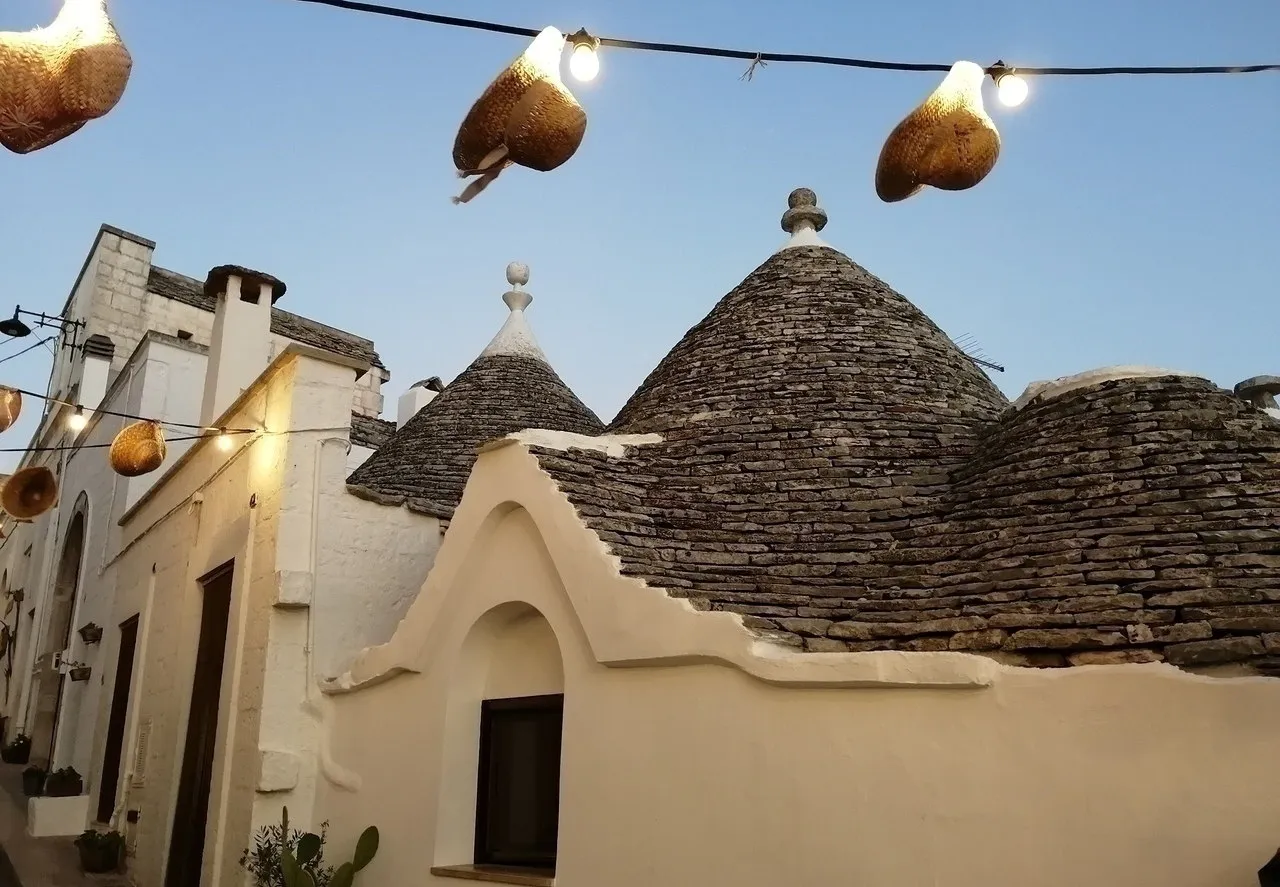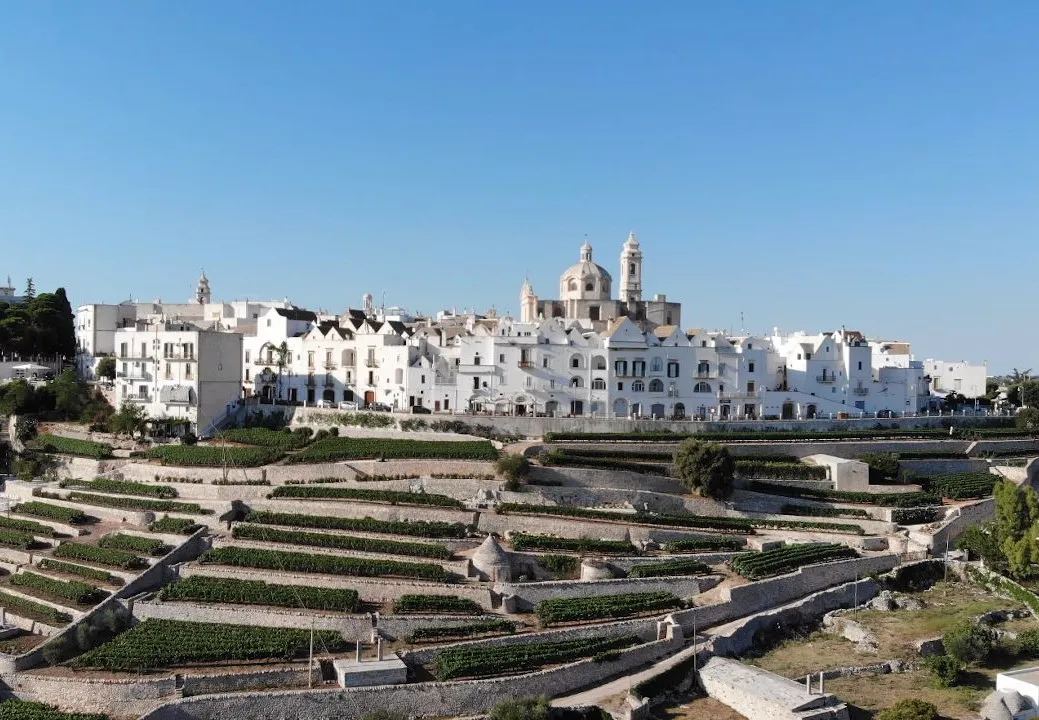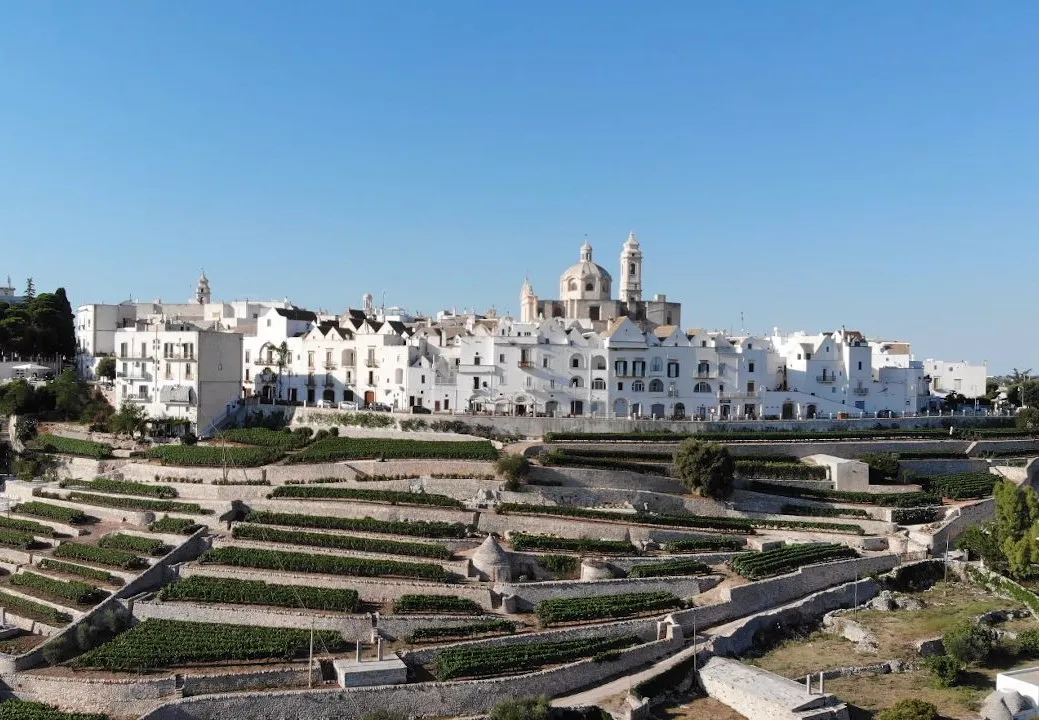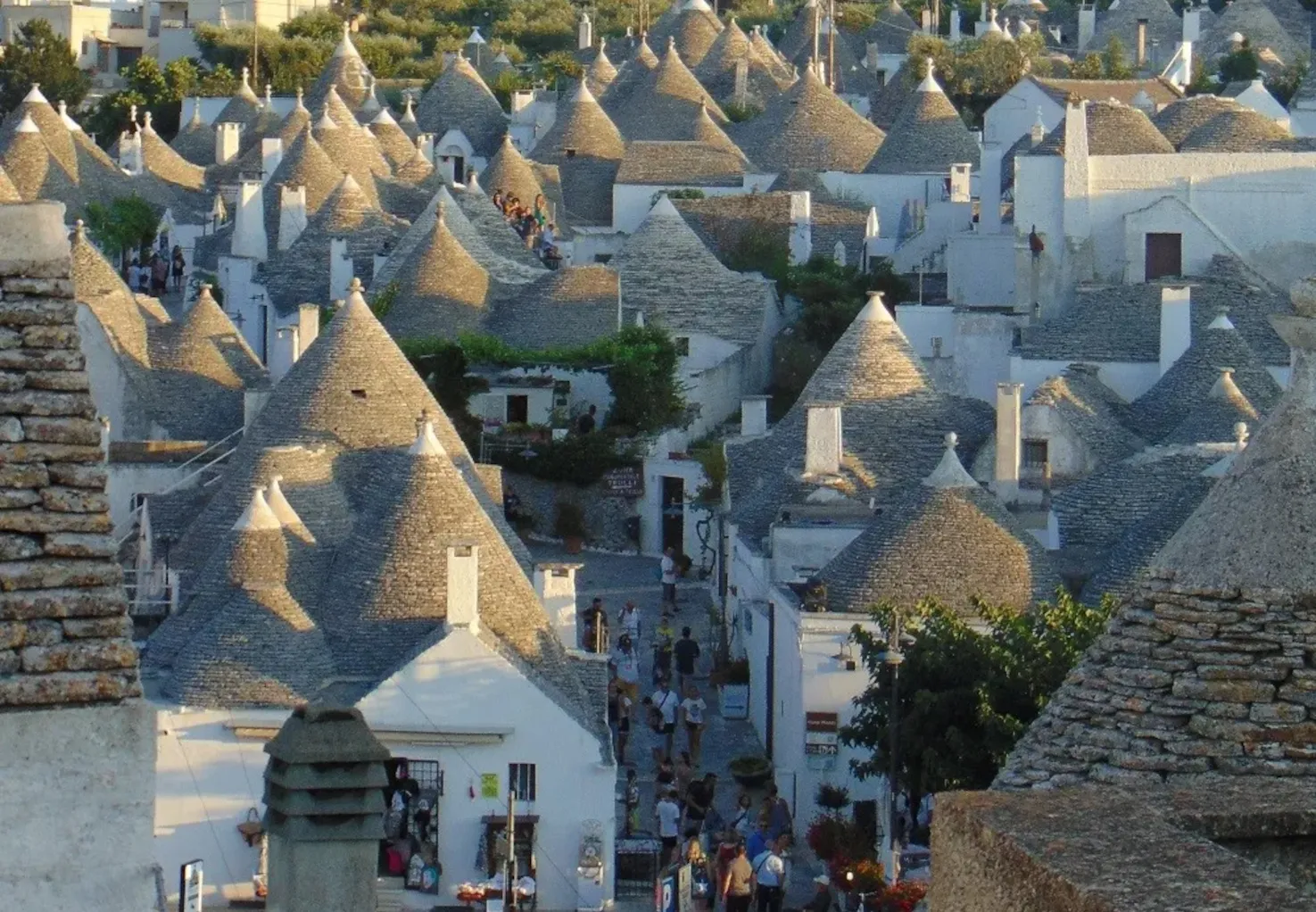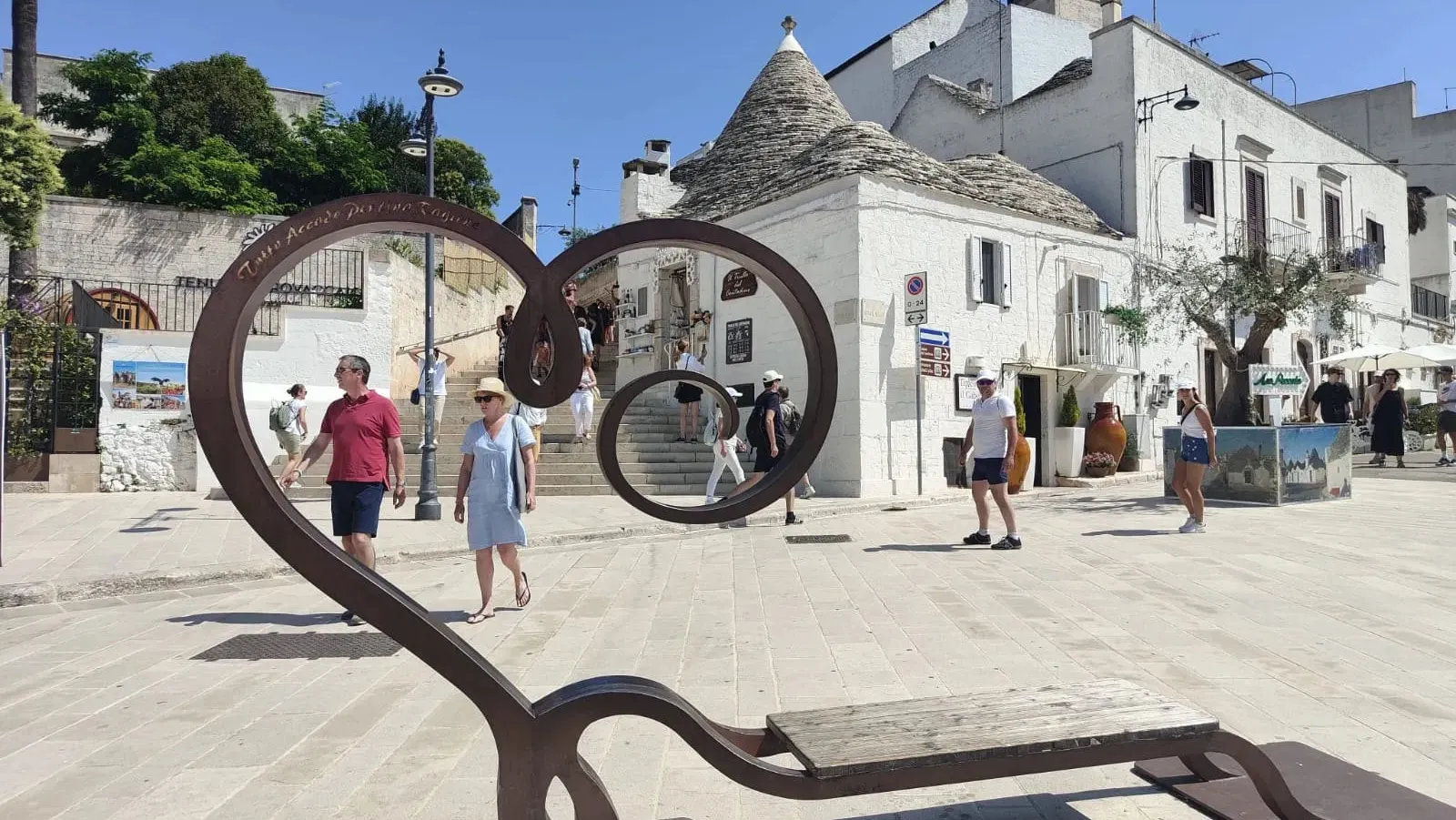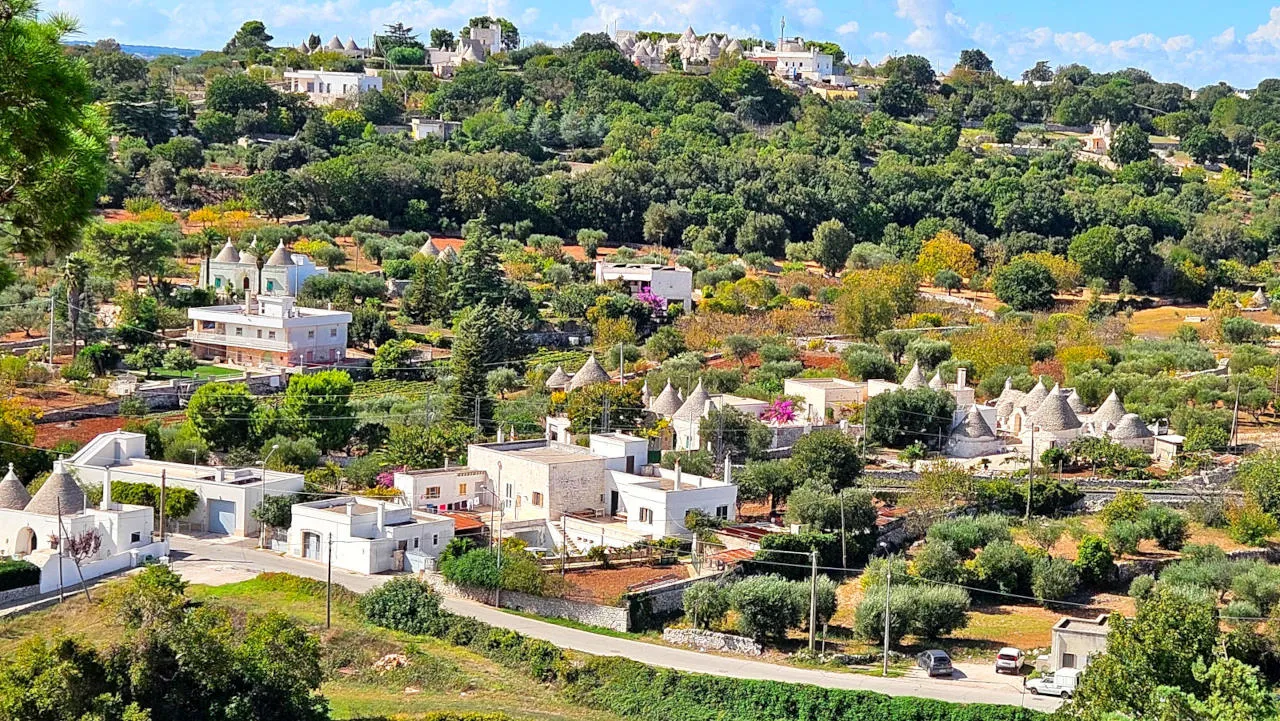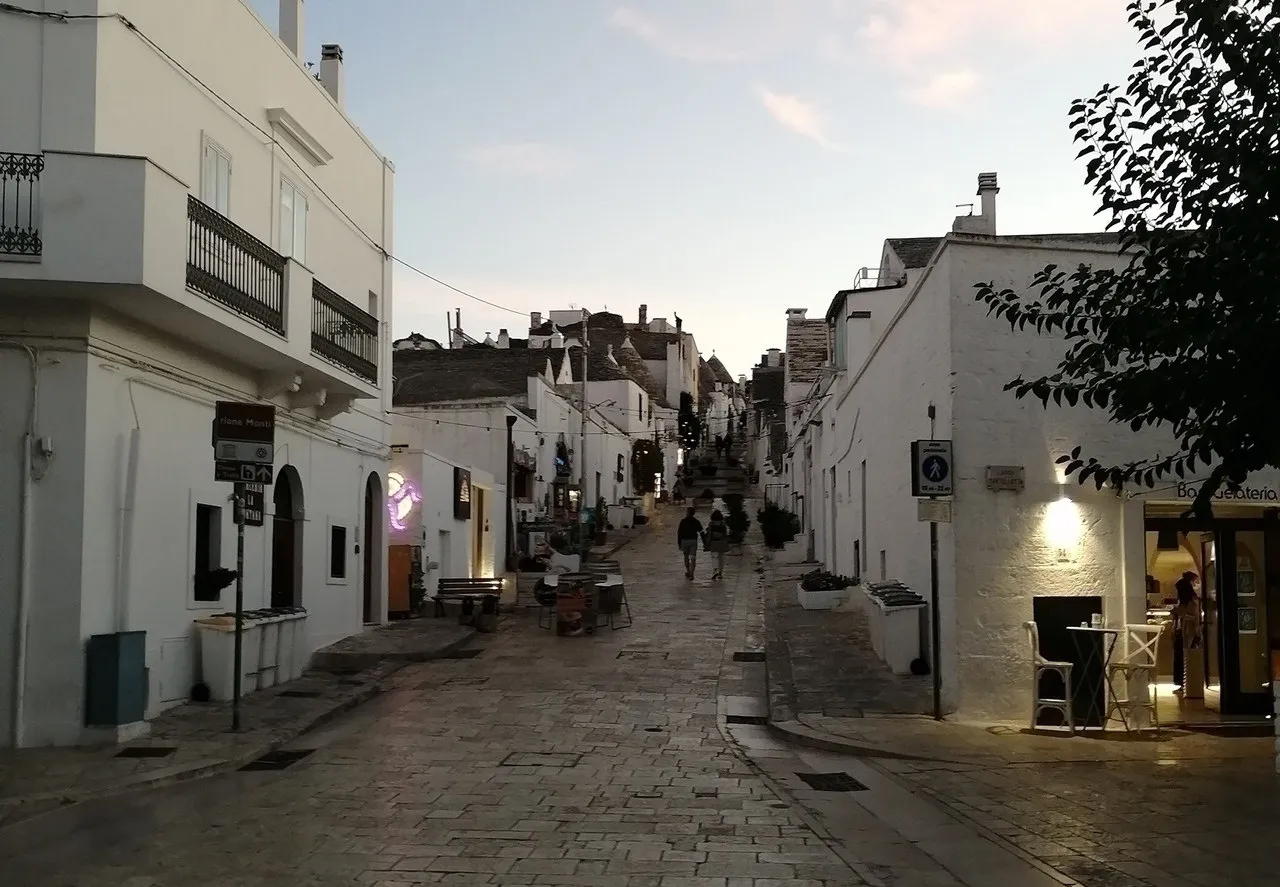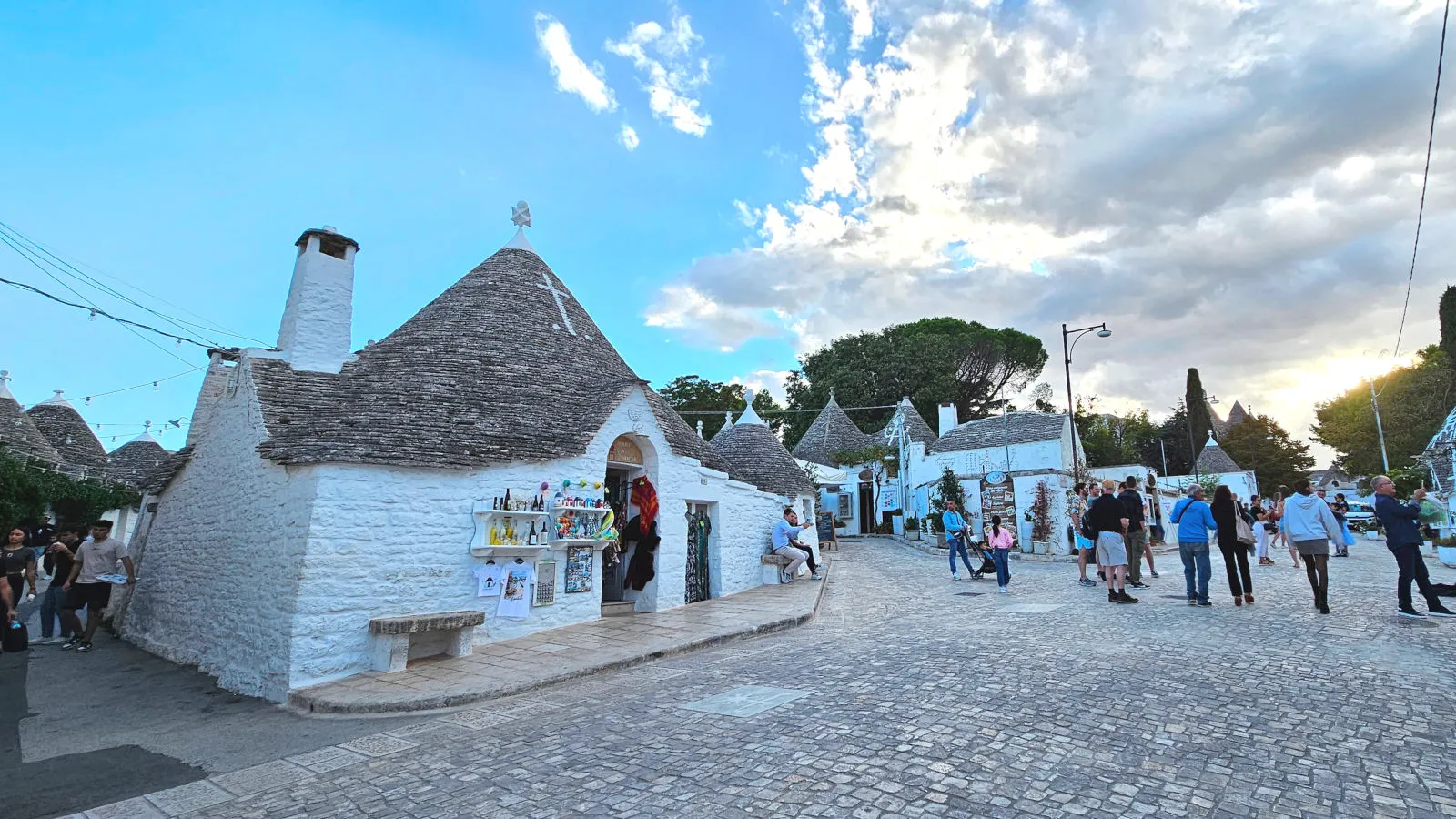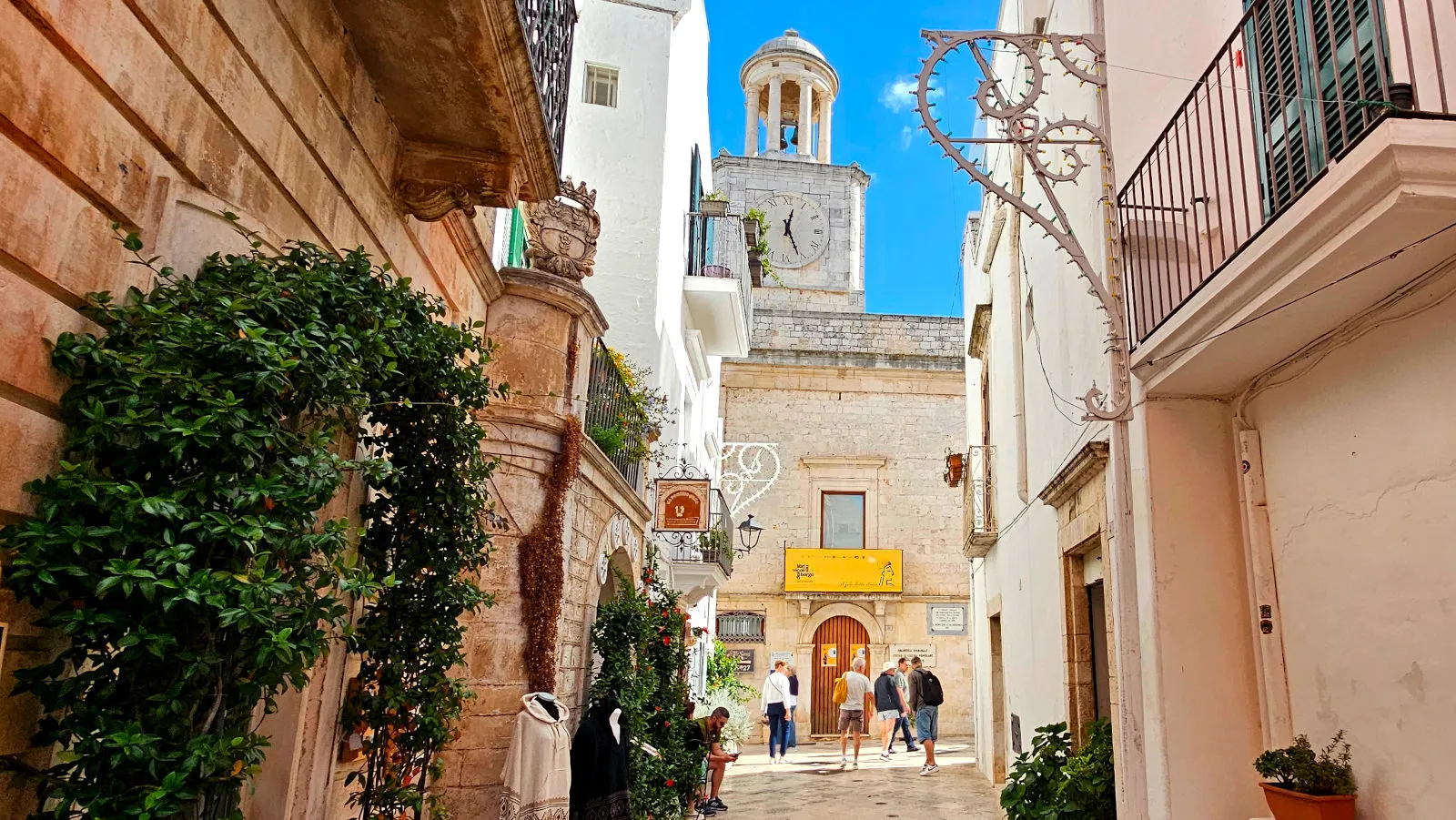Locorotondo: what to see and what to do
Updated at: 01-12-2024
How this content can help you:
- You will discover the historic center of Locorotondo with its unique "Cummerse" and baroque architecture.
- You will admire views of the Itria Valley from the panoramic terraces.
- You will get to know local crafts: ceramics, embroidered fabrics, and traditional objects.
- You will find out what to do in Locorotondo: traditional events, visits to trulli, and historic masserie.
- You will learn about the typical wine and olive oil traditions of Puglia.
- You will explore points of interest such as the Trullo Marziolla and the Sanctuary of the Madonna della Catena.
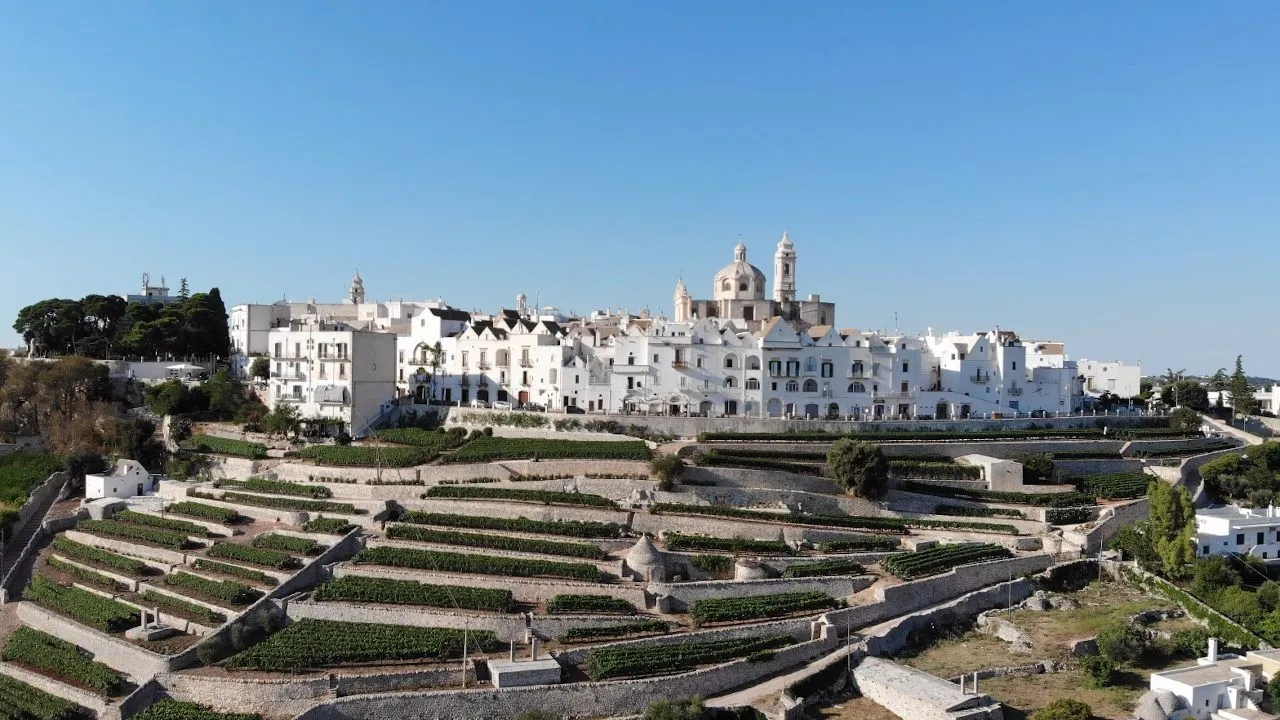
Locorotondo is one of the most characteristic ancient villages of Puglia, officially recognized among the most beautiful villages in Italy, and is one of the major tourist attractions of the region. The territory of Locorotondo is part of the "land of the Trulli" and is located in the Valle d'Itria where there are archaeological evidence indicating the first ancient settlements dating back to the 3rd millennium BC.
Locorotondo is a village built between the 9th and 7th centuries BC in the province of Bari, and is located between the municipalities of Fasano (BR), Alberobello (BA), Cisternino (BR) and Martina Franca (TA), in the southern part of the Murge plateau. Locorotondo is made up of over 150 districts, hamlets and small agricultural communities, which have developed over the centuries around Trulli, Masserie, Churches, Wells or squares scattered throughout the territory and the surrounding countryside.
The name Locorotondo comes from the late Latin Locus Rutundus, which means round place. Already in ancient times the village enclosed in the walls, due to its expansion towards the top of the hill, assumed that round shape which then gave it its name.
The municipality of Locorotondo had many names before the current one: initially it was called Casale San Giorgio in honor of the patron saint, then Casale Rotondo, then Luogorotondo and only in 1834 Locorotondo.
The surrounding countryside is characterized by the massive presence of vineyards, about 15% of the area's crops, olive groves, cereals, fruit crops and other crops which extend as far as the eye can see among wooded spots in the area.
Locorotondo initially developed around the Benedictine monastery of Santo Stefano on top of the hill over 400 meters high, where today it stands out, with its white color and its circular shape, immersed in the lush surrounding countryside mainly cultivated with vines, cereals and olives.
Locorotondo, with its territory, offers a combination of beauty, culture and history that make it a unique place in the world, capable of enchanting visitors of all ages and backgrounds.
Locorotondo what to see
Among the most beautiful things to see in Locorotondo there are:
- Church of San Rocco
- Mother Church of San Giorgio Martire
- Morelli Palace
- Town Hall and Civic Tower
- Trulli Marziolla
- Municipal Villa
- Sanctuary of the Madonna della Catena
- Trulli
- Farmhouses
- Views of the Itria Valley
Church of San Rocco
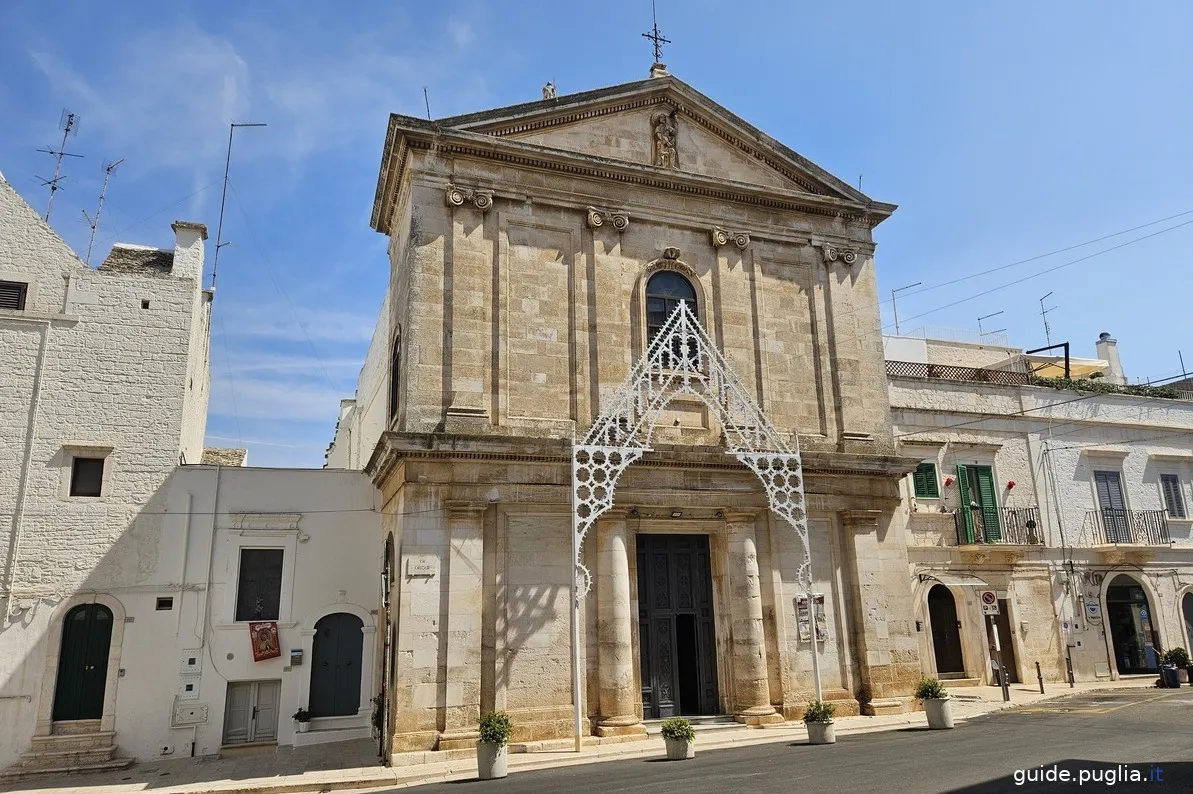
The Chiesa di San Rocco is an important place of worship dedicated to Saint Roch, the patron saint of the town. The Chiesa di San Rocco is a religious building of great historical and artistic significance for the community.
Built in the 18th century, the church features a Baroque-style façade and a richly decorated interior with frescoes and statues. The statue of Saint Roch, carried in procession during the festival, is kept inside the church and represents an object of great devotion for the faithful.
The feast of San Rocco in Locorotondo is a special occasion that unites tradition, faith, and culture, keeping alive the bond between the community and its patron saint.
The Patronal Feast of San Rocco
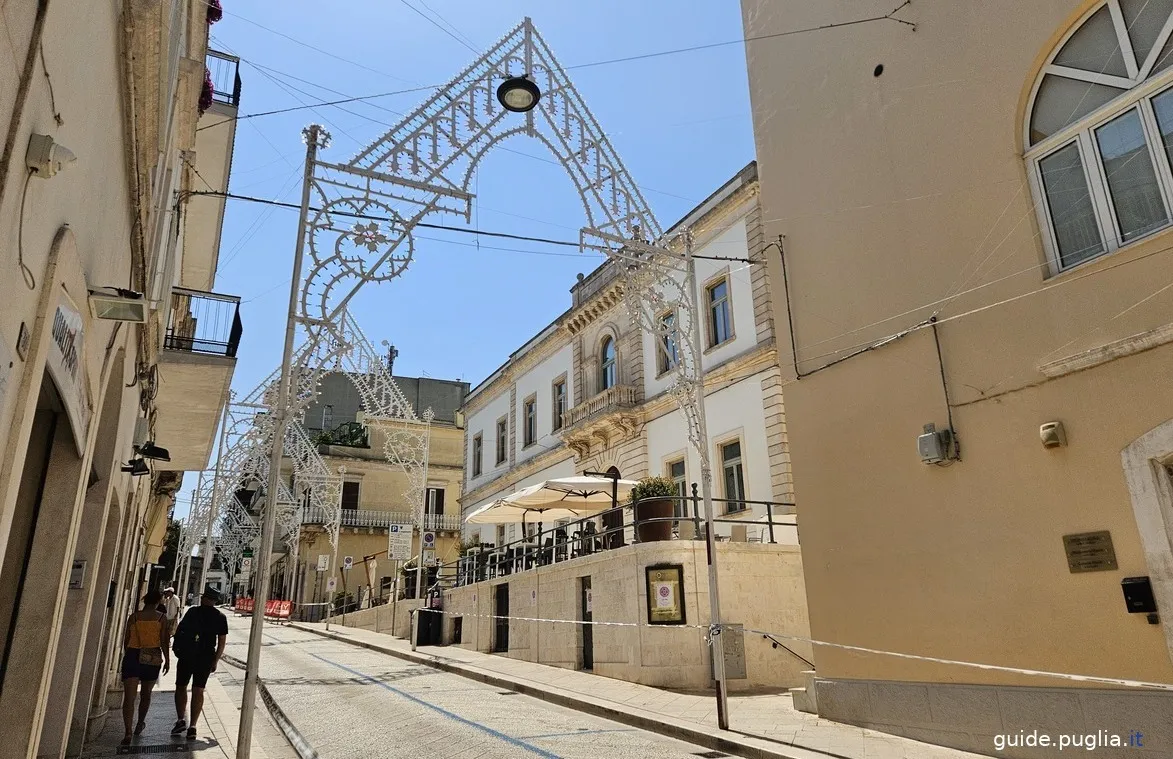
Every year on August 16th, the community of Locorotondo celebrates the patronal feast of San Rocco with great devotion and participation.
One of the main attractions of the feast is the procession through the streets of Locorotondo, during which the statue of Saint Roch is carried on the shoulders of the faithful. The procession is accompanied by prayers, religious songs, and music from the local band.
Mother Church of San Giorgio Martire
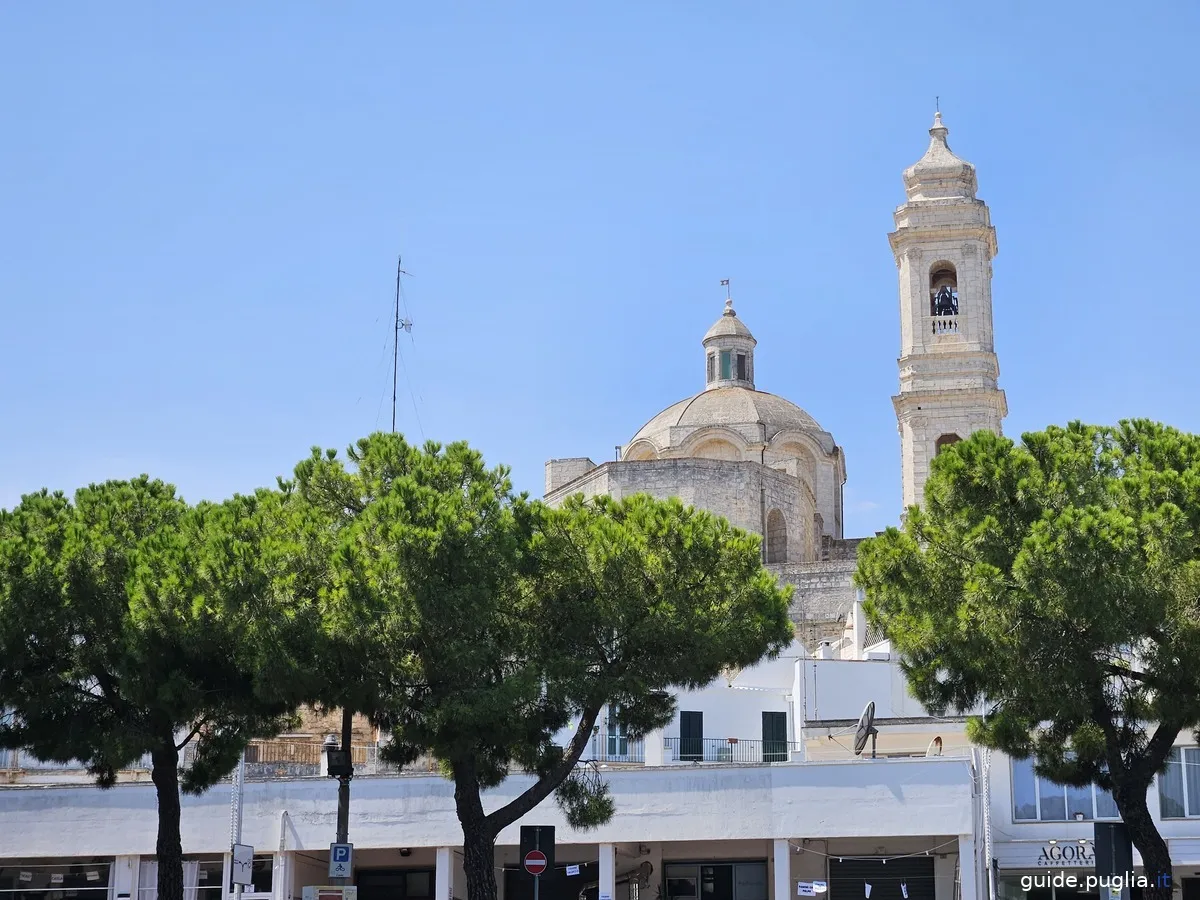
The Mother Church of San Giorgio Martire, located in the heart of the historic center, is one of the most beautiful and iconic places in Locorotondo.
The church is a masterpiece of Apulian Baroque, rich in works of art and valuable decorations, with an imposing and majestic facade, with a large stone portal and a bell tower that rises towards the sky. The interior is a riot of stuccos, frescoes and sculptures, which bear witness to the great skill of local artists.
One of the points of greatest interest is the high altar, where there is the statue of San Giorgio, the patron saint of the city. The statue, made of papier-mâché and covered in silver, is one of the treasures of the church and attracts thousands of faithful every year on the occasion of religious holidays.
Other elements of great interest are the ceiling frescoes, which represent the Glory of St. George and the Virgin Mary, and the side chapels, each dedicated to a different saint.
The Mother Church of San Giorgio Martire is a place of great historical and cultural importance for the community of Locorotondo, but also for all visitors who want to discover the beauty and spirituality of Puglia.
Morelli Palace
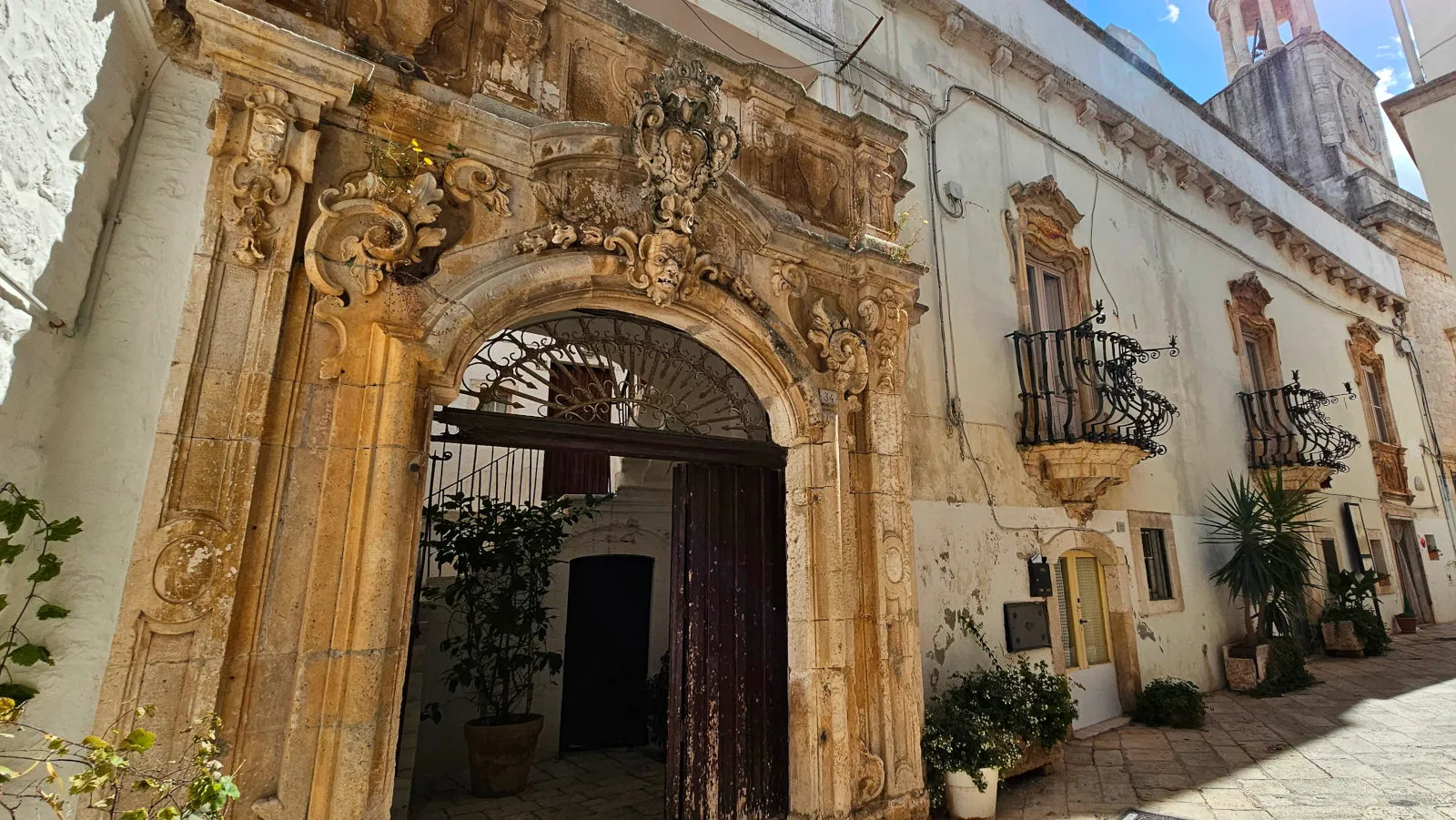
Located in the heart of the picturesque town of Locorotondo, Palazzo Morelli is a historic Baroque building of great architectural beauty and cultural value. Built in the 18th century, this former palace stands imposingly in the city centre, with its white facade and distinctive dome.
Palazzo Morelli is one of the most representative buildings of Locorotondo, built in Baroque style with numerous decorative elements, and represents an important testimony of local history and culture.
Palazzo Morelli is one of the most popular destinations for visitors due to the building's remarkable example of Apulian Baroque architecture.
Inside, Palazzo Morelli houses numerous works of art and collections of great historical value, including paintings, sculptures and handicrafts. The structure has been renovated and reopened to the public after years of restoration, and is now open for guided tours and cultural events.
In summary, Palazzo Morelli represents an architectural and cultural jewel of great value, which bears witness to the history and beauty of Locorotondo. Its central location, the beauty of its decorations and the presence of numerous works of art make it a must-see destination for anyone visiting the city.
The portal of the building bears the noble coat of arms of the Morelli family, depicted in an elephant supporting a tower, and is surrounded by sculptures, works and highly prized architecture of Baroque art.
Balconies, balustrades, mirrors, arches enriched with moldings and masks with a mocking grin enrich the facade and the entrance hall of the building.
Internally the building was structured on 3 levels, accessible from the stairway located in the entrance hall. The basement is created in a space with traditional barrel vaults.
The first floor was instead dedicated to the lodgings of the nobility of the time. The second and top floor, with lower barrel vaults, was dedicated to warehouses.
All the baroque art of the palace and of the interiors is available to the visitor who wants to travel through time in the Apulian baroque art.
Town Hall and Civic Tower
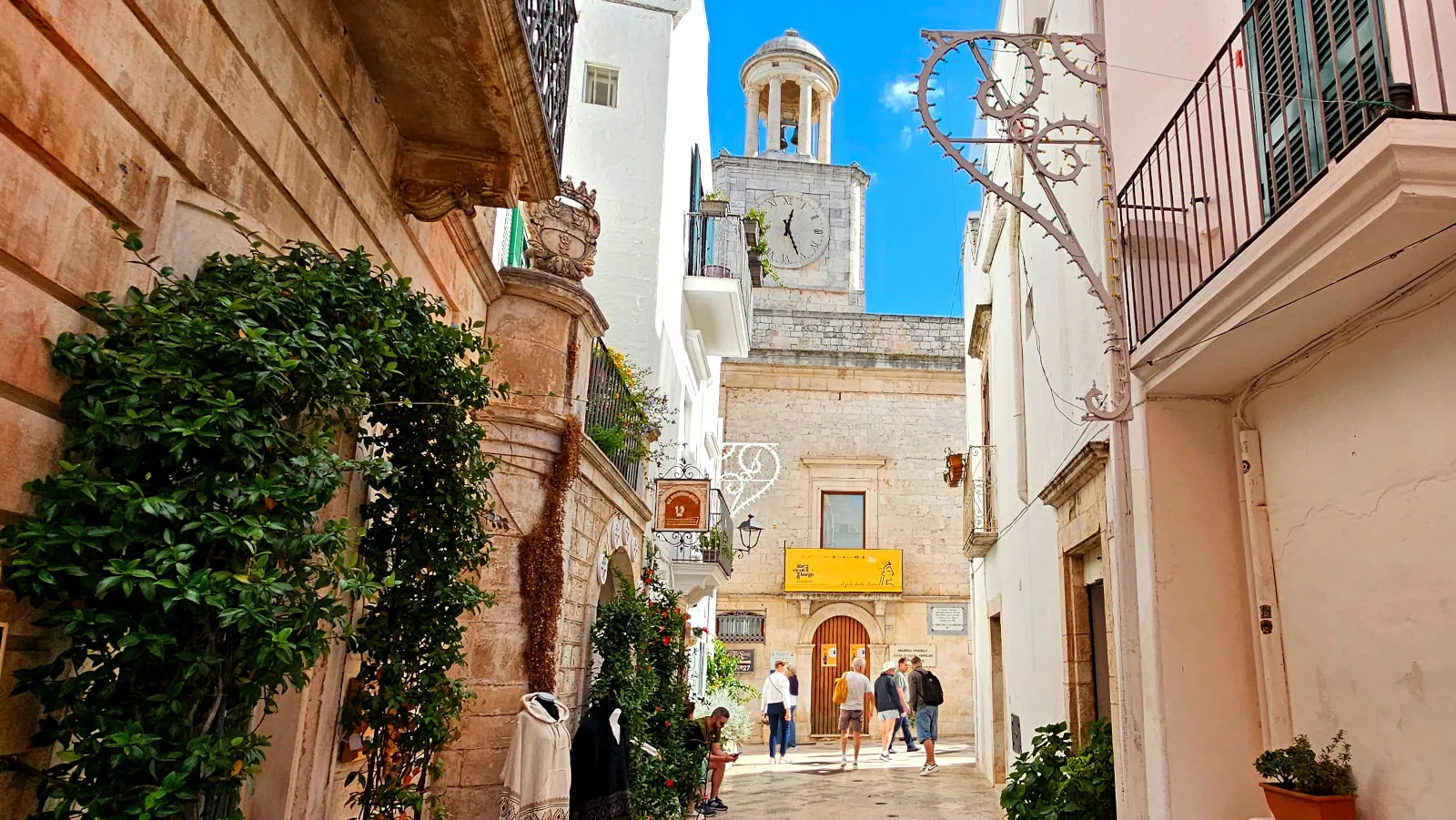
The Palazzo Comunale and the Civic Tower of Locorotondo represent one of the most important symbols of the city and an important testimony of its history and culture. Located in the historic centre, these two historic buildings are an example of medieval and Renaissance civil architecture.
The old Palazzo Comunale, built in the 18th century, is an imposing and majestic building dominated by the Civic Tower, with a white stone facade and windows decorated with Baroque-style arches. Today it houses the Civic Library but once it housed the municipal hall and the university.
Inside the palace, numerous paintings and works of art can be admired that tell the story of the city and its traditions.
The Civic Tower, about 22 meters high, was built later, at the beginning of the 19th century, and represents one of the most recognizable symbols of Locorotondo. This imposing white stone tower, which dominates the panorama of the city, was used as a watchtower and defense. Today it is possible to climb the tower and enjoy a breathtaking view of the city and the surrounding countryside.
The Civic Tower included the clock removed from the bell tower of the Mother Church and subsequently, in 1820, it was further modified by erecting a circular structure formed by parts coming from the already abandoned bell tower of the church.
The structure was later modified to such an extent, with the expansion of the building to occupy part of Via Maggiore, in the stretch that led from Porta Napoli to the Mother Church.
Today the spacious rooms of the building, open to visitors, house the Archaeological Documentation Center and the Historical Archive of Locorotondo.
The Palazzo Comunale and the Torre Civica are places of great cultural and historical importance for the city of Locorotondo and are often used to host art exhibitions, cultural events and official ceremonies. Thanks to their beauty and their millenary history, these two buildings have become one of the main tourist attractions of the region.
In summary, the Palazzo Comunale and the Civic Tower of Locorotondo are two places of great architectural and cultural beauty, which bear witness to the history and culture of the city. Their central location and the presence of numerous works of art make them a must-see destination for anyone visiting the city.
Trullo Marziolla
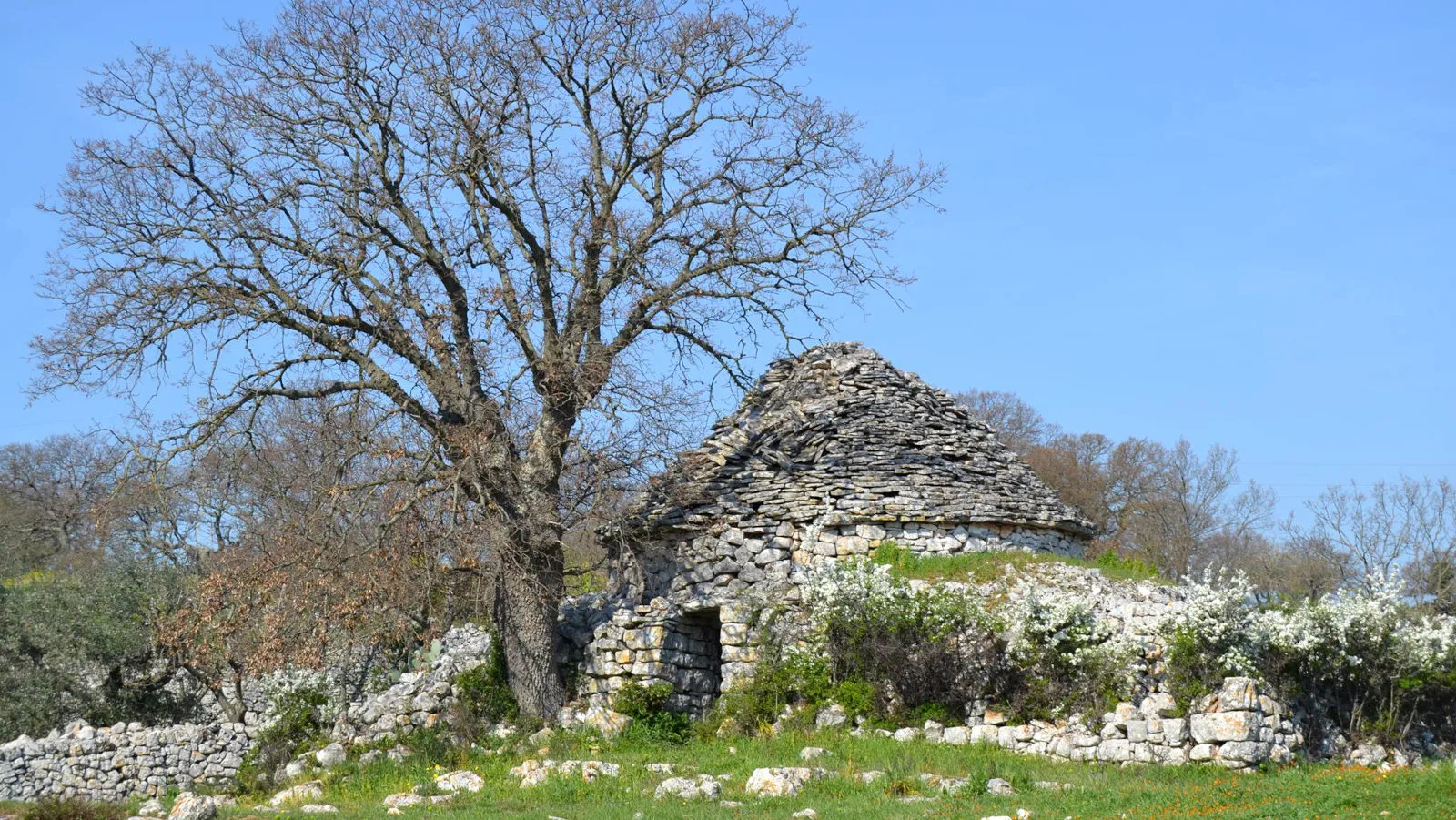
The Trullo Marziolla is the oldest documented trullo in the whole Valle d'Itria (the Valley of the Trulli) and dates back to 1559 as reported on the entrance door of the trullo.
As the name suggests, the trullo is located in Contrada Marziolla, in Locorotondo, an area quite rich in vineyards.
The structure consists of a trullo, a rural construction typical of the Itria Valley built with local dry stones, with a domed roof that rises over 5 meters in height.
From the press inside, with basins and channels capable of conveying the must in cisterns, and from the stone wine press (the millstone) located outside, it is clear that the trullo was probably commonly used for the tightening of grapes from all farmers who worked the vines around them.
Visiting the Trullo Marziolla is the best way to discover the peasant origins of the city of Locorotondo and to fully understand the culture and traditions.
Municipal Villa
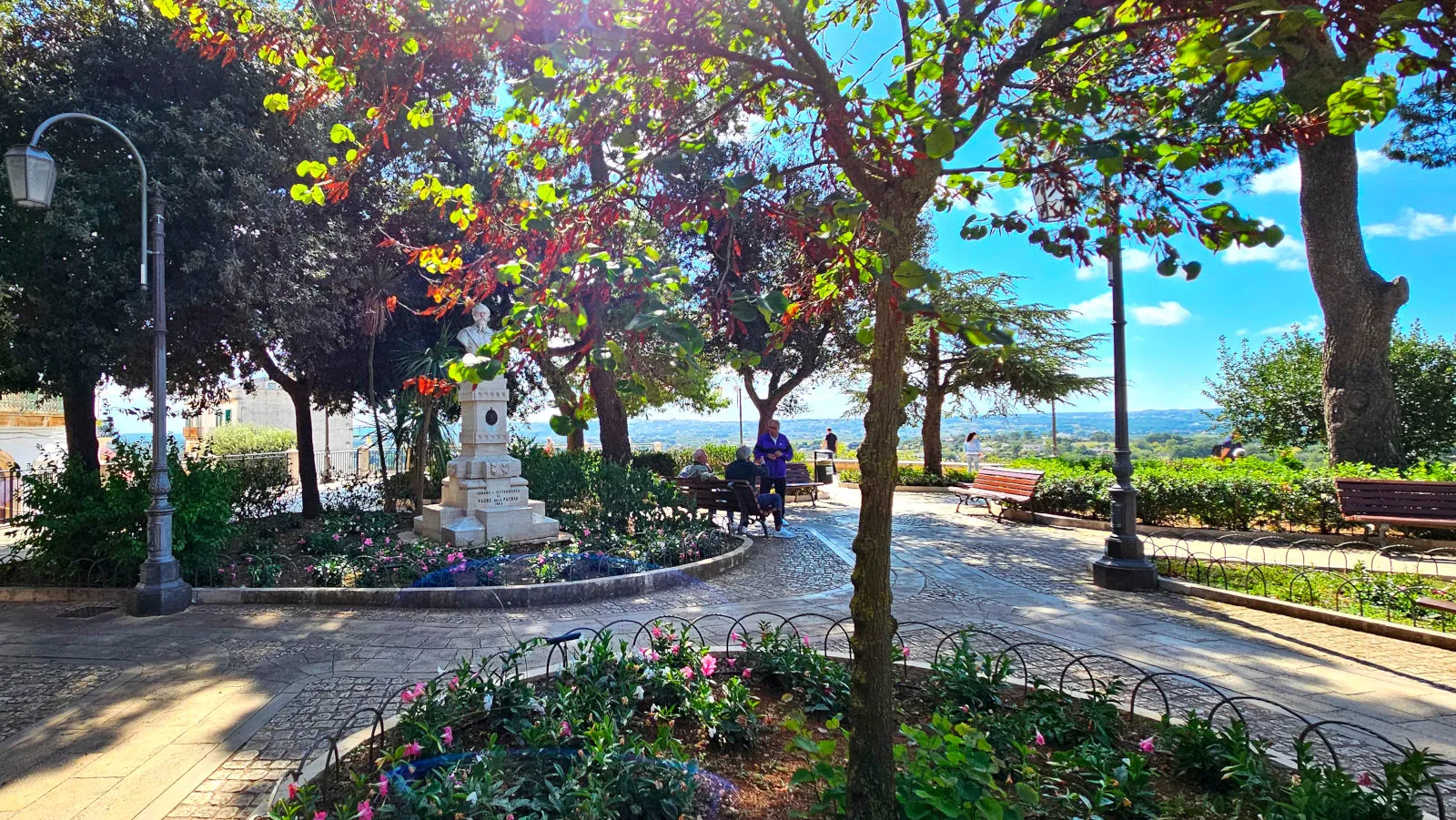
The Villa Comunale is a park located on the side of a hill outside the walls, right in front of the spectacular Piazza Dante Alighieri.
The hill on which the Municipal Villa is located, called Monte Grappa, is an excellent place from which to enjoy the lush panorama of the Itria Valley.
Sanctuary of the Madonna della Catena
The Sanctuary of the Madonna della Catena is one of the most important places of worship in Locorotondo. Located a few kilometers from the historic centre, the sanctuary has been a destination for pilgrimages and devotions for centuries.
The history of the sanctuary dates back to 1597, when a group of shepherds found an image of the Madonna della Catena in a field near the river Sele. The statue was brought to Locorotondo and, since then, has become an object of great veneration for the local community.
The sanctuary, built in the 17th century, is a majestic and imposing building, with a Baroque-style facade and a 50-metre-high bell tower. The interior is rich in decorations and works of art, including the high altar in polychrome marble, the statue of the Madonna della Catena and an 18th-century pipe organ.
One of the most exciting moments for the faithful is the procession of the Madonna della Catena, which takes place on August 15th each year. During the procession, the statue is carried on the shoulders of the faithful through the streets of Locorotondo, in an atmosphere of great devotion and emotion.
The Sanctuary of the Madonna della Catena is a place of great spirituality and history, which represents an important testimony of the faith and devotion of the Apulians. If you are visiting Locorotondo, you cannot miss the opportunity to get to know this magical place and to breathe its atmosphere of peace and serenity.
Trulli of Locorotondo
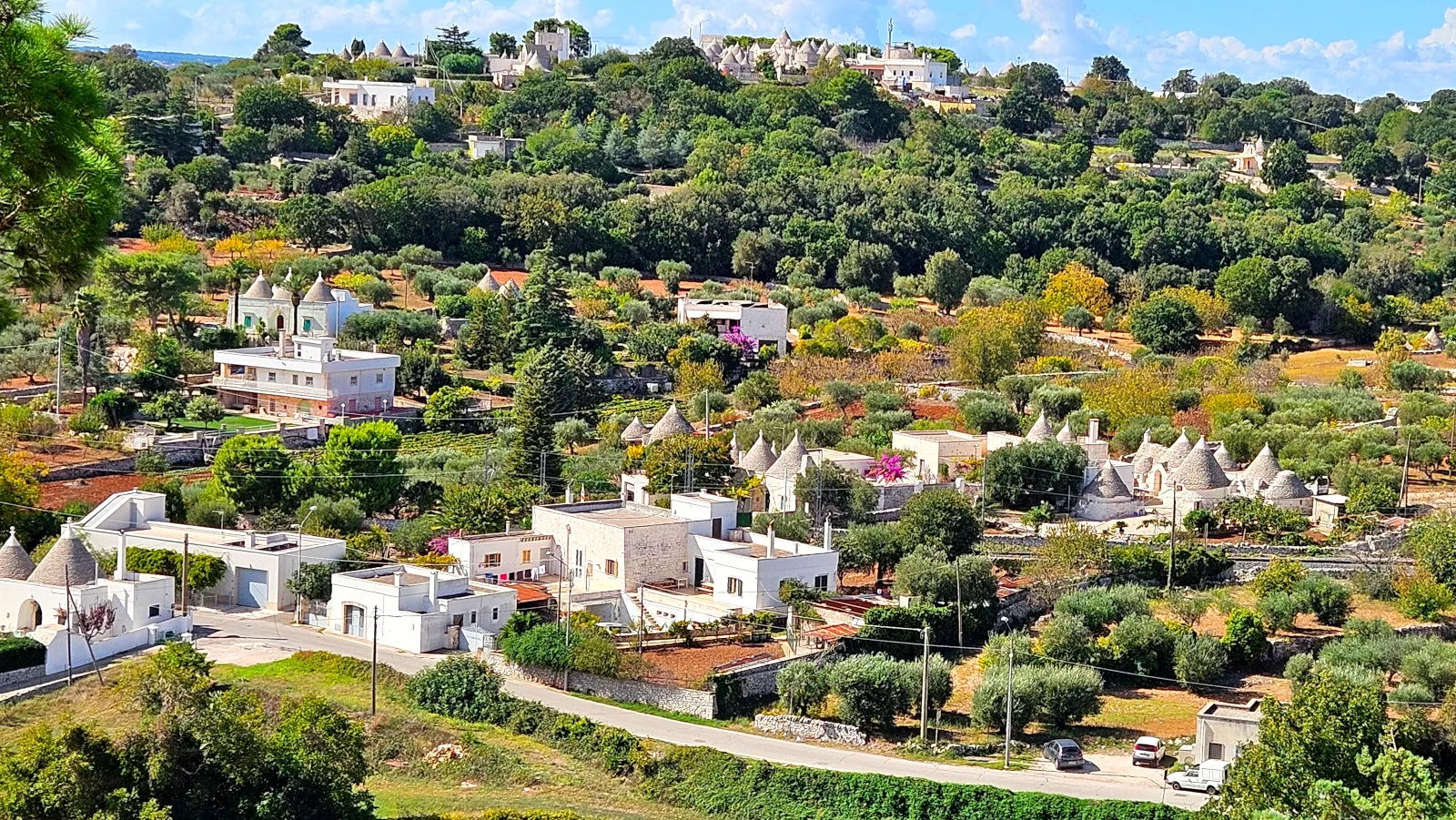
The Trulli of Locorotondo in Valle d'Itria are one of the most representative symbols of the Puglia region. These particular conical-shaped stone buildings are present in large numbers in the Valle d'Itria, an area that extends between the towns of Locorotondo, Cisternino and Martina Franca. Thanks to their unique structure and their millenary history, the Trulli represent an unmissable destination for tourists who wish to discover the beauty and tradition of Puglia.
The Trulli are dry stone buildings, without mortar, which date back to the 17th century. These buildings were used in the past as rural houses by the farmers of the region, but today many of these buildings have been restored and transformed into charming tourist residences. The conical shape of the roof of the Trulli serves to protect the structure from bad weather, and their thick masonry guarantees excellent thermal insulation, making them cool in summer and warm in winter.
Each Trullo is made up of one or more rooms, and usually has a living area with fireplace, an equipped kitchen, one or more bedrooms and a bathroom. Some Trulli also have private gardens and swimming pools, thus offering the possibility of experiencing a holiday immersed in nature and in the silence of the Apulian countryside.
The Trulli of Locorotondo in Valle d'Itria are an ideal destination for tourists who wish to have a unique and authentic experience, discovering the culture and tradition of Puglia. Thanks to their strategic position, the Trulli also represent an ideal starting point for visiting the art cities of the region, such as Alberobello, Ostuni and Lecce. Thanks to their beauty and their uniqueness, the Trulli of Locorotondo in Valle d'Itria represent a perfect holiday destination for couples and families, but also for groups of friends looking for a special and authentic place to spend their holidays.
Masserie in Locorotondo
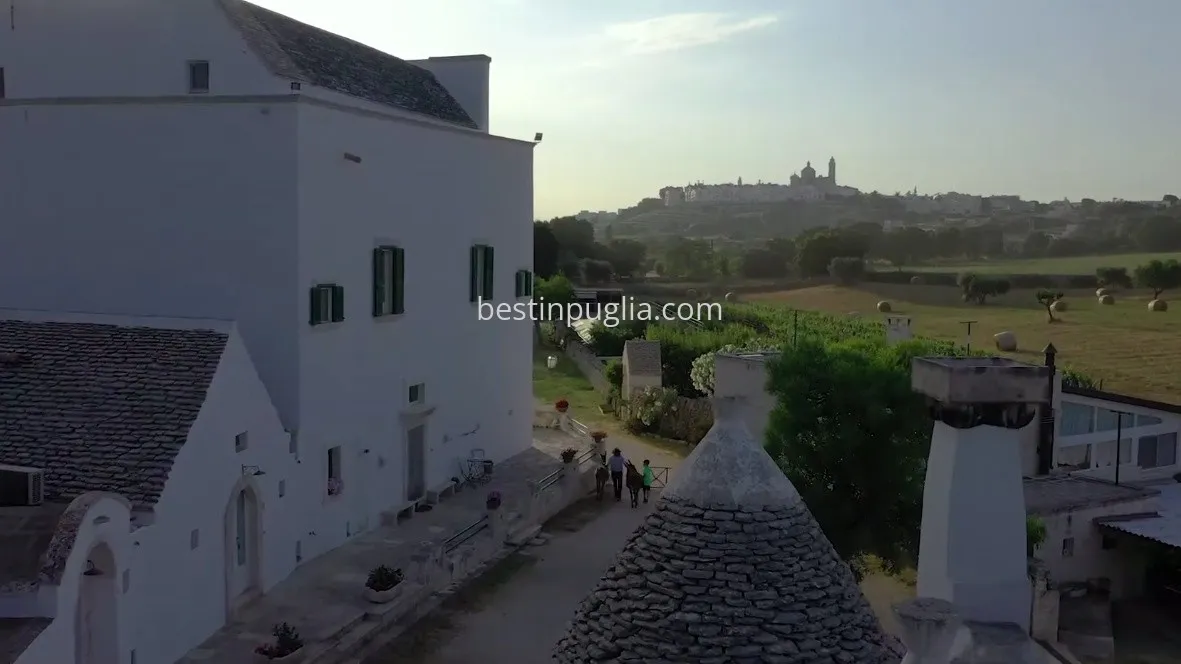
The Masserie, or farmhouses, in the countryside of Locorotondo in Valle d'Itria represent a true treasure of the Puglia region. These ancient stone buildings, some of which are real fortified citadels, date back to the period in which Puglia was still an agricultural region, and the farmhouses were used as homes by local farmers and as places of production and storage of various agricultural products.
Today many of these farms have been renovated and transformed into beautiful country residences, equipped with all modern comforts, but which still retain the charm of the ancient Apulian tradition. Most of these farms are located in the Valle d'Itria, an area that extends between the towns of Locorotondo, Cisternino and Martina Franca, characterized by a unique landscape in the world, with undulating hills, fields planted with olive trees and vineyards and numerous trulli scattered throughout the territory.
Masserie in the Itria Valley are often surrounded by large gardens and farmland, where it is possible to relax and enjoy the beauty of the surrounding nature. Inside, the farms have large rooms, often decorated with frescoes and period furnishings, which recall the millenary history of the region. Many of these farms also have private swimming pools, tennis courts and barbecue areas, ideal for spending relaxing moments with friends and family.
The Masserie in the countryside of Locorotondo in Valle d'Itria represent the ideal solution for those who wish to have an authentic and immersive experience in the Apulian culture and tradition, without giving up the comfort and luxury of modern country residences. Thanks to their strategic position, the Masserie in the Valle d'Itria also represent the ideal starting point for visiting the art cities of the region, such as Alberobello, Ostuni and Lecce.
Panoramic view of the Itria Valley
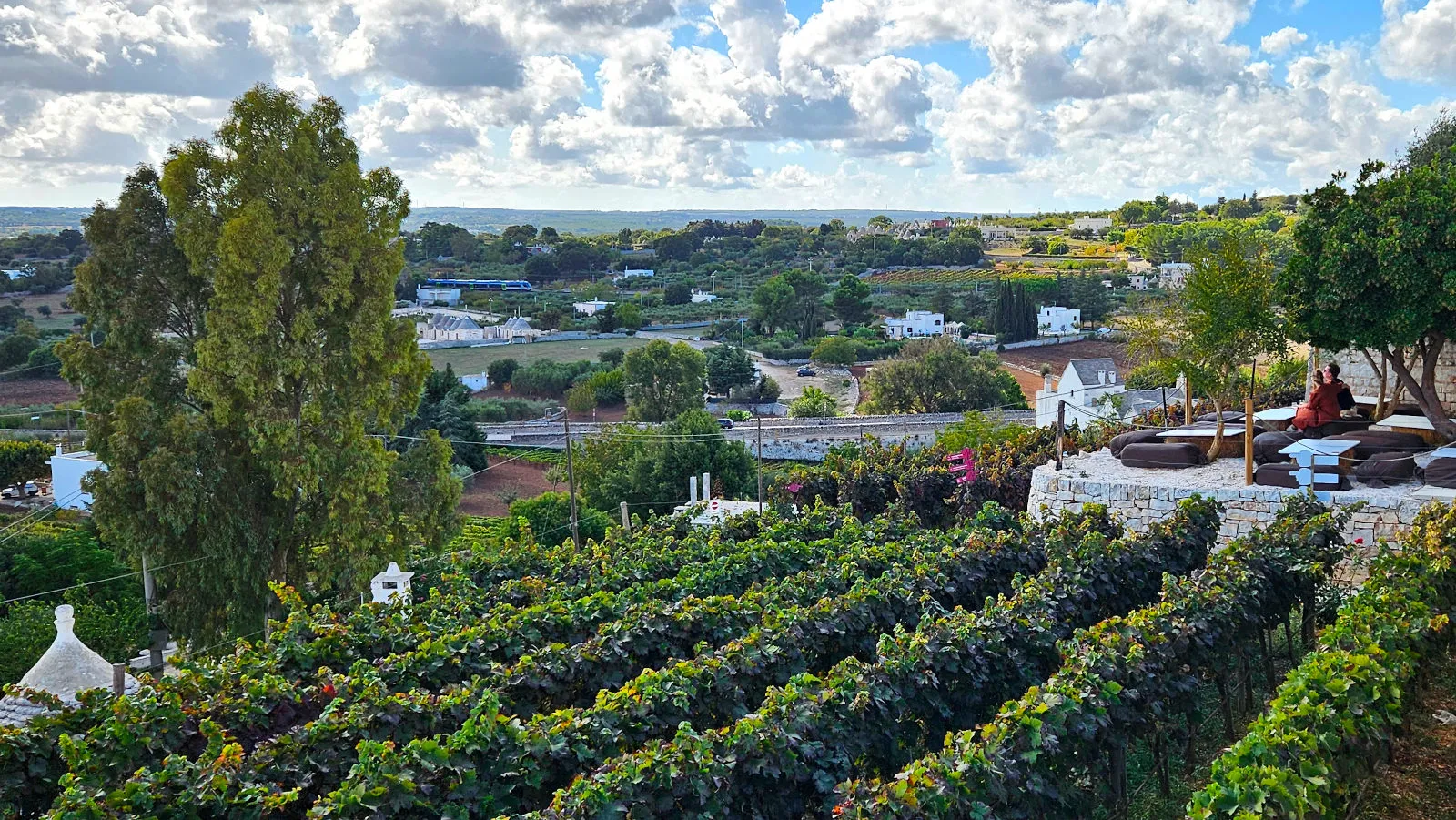
The panoramic view of Locorotondo in the Itria Valley is a sight not to be missed by anyone visiting Puglia. Located in the heart of the Valle d'Itria, the city of Locorotondo offers visitors a breathtaking panoramic view, characterized by the typical cone-shaped houses, the countryside planted with olive trees and vineyards, and the surrounding hills which offer a spectacle of rare beauty.
The panoramic view of Locorotondo can be admired from various points of the city, but one of the most suggestive is certainly the Belvedere, located on the top of the hill in the historic centre. From the Belvedere terrace you can admire the entire city and the surrounding countryside, which extends to the coast of the Adriatic Sea.
But not only the Belvedere offers a spectacular panoramic view: even walking through the streets of the historic center you can admire suggestive glimpses, such as the panorama that opens from Piazza Vittorio Emanuele II, with a view of the Mother Church of San Giorgio and the surrounding countryside .
The panoramic view of Locorotondo in Valle d'Itria represents an unforgettable experience for anyone who loves the beauty of nature and history. Walking through the streets of the historic center, admiring the typical cone-shaped houses, and enjoying the panoramic view of the surrounding countryside are just some of the activities that can be done in Locorotondo. If you are planning a visit to Puglia, do not miss the opportunity to admire the panoramic view of Locorotondo, a one-of-a-kind spectacle that will remain etched in your memory.
Locorotondo Center
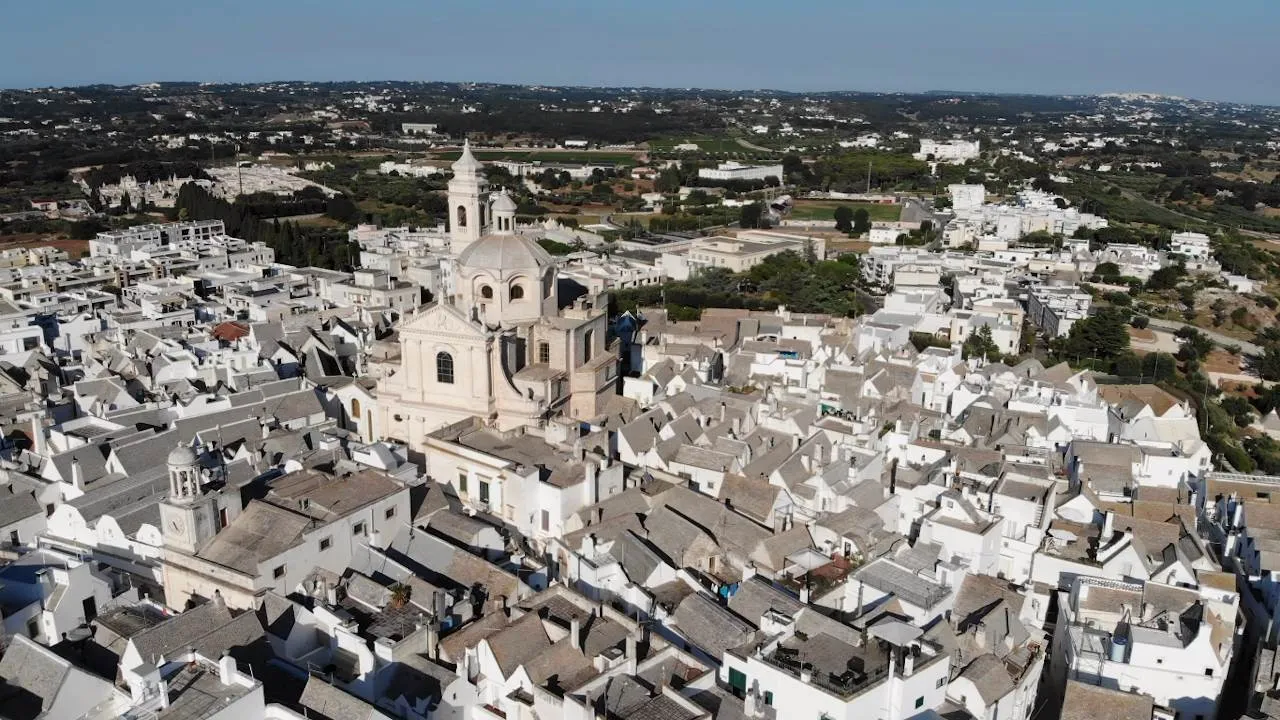
The historic center of Locorotondo is an enchanting village, nestled among the hills of the Valle d'Itria, where time seems to have stood still. Its narrow, winding streets, the sloping stone roofs of the Cummerse, the white stone of the houses, and the cone-shaped roofs of the trulli make it one of the most picturesque places in Puglia.
A visit to the historic center of Locorotondo begins at Piazza Vittorio Emanuele, where, passing through the two large pillars of Porta Napoli, you can follow a route that takes you through the points of interest within the walls.
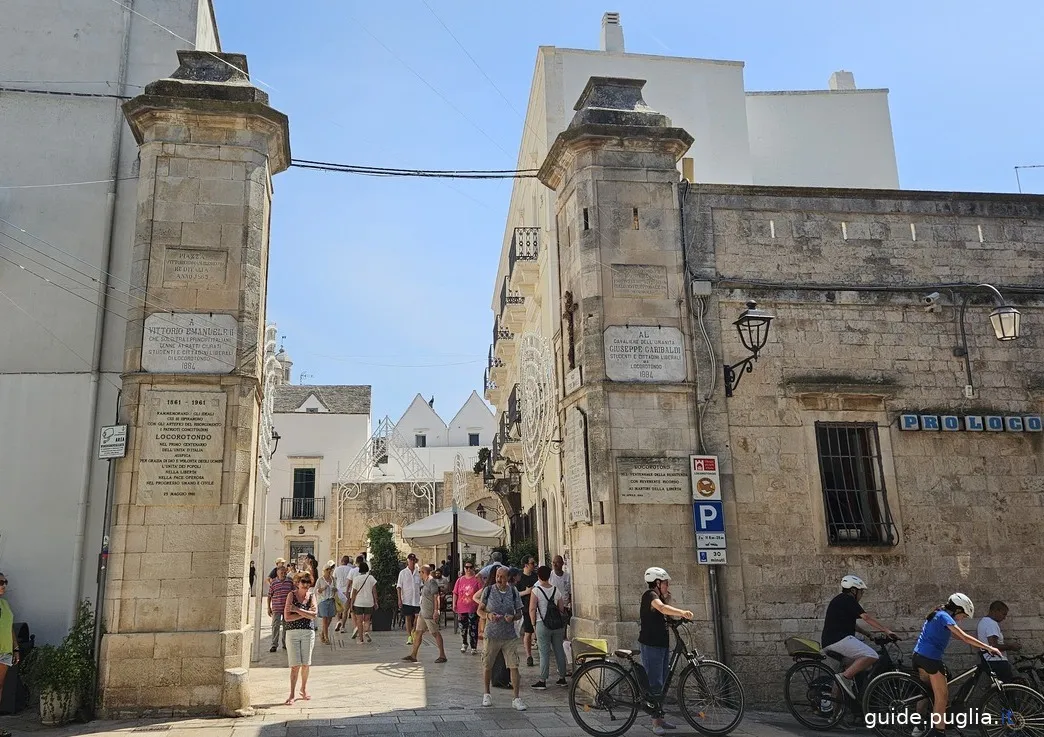
As you stroll through the streets of the village, you cannot help but notice Palazzo Morelli, the ancient town hall, now the public library. It is an 18th-century building that overlooks the main square. The Baroque portal, the ornate windows, and the wrought-iron balcony make it a fine example of local architecture.
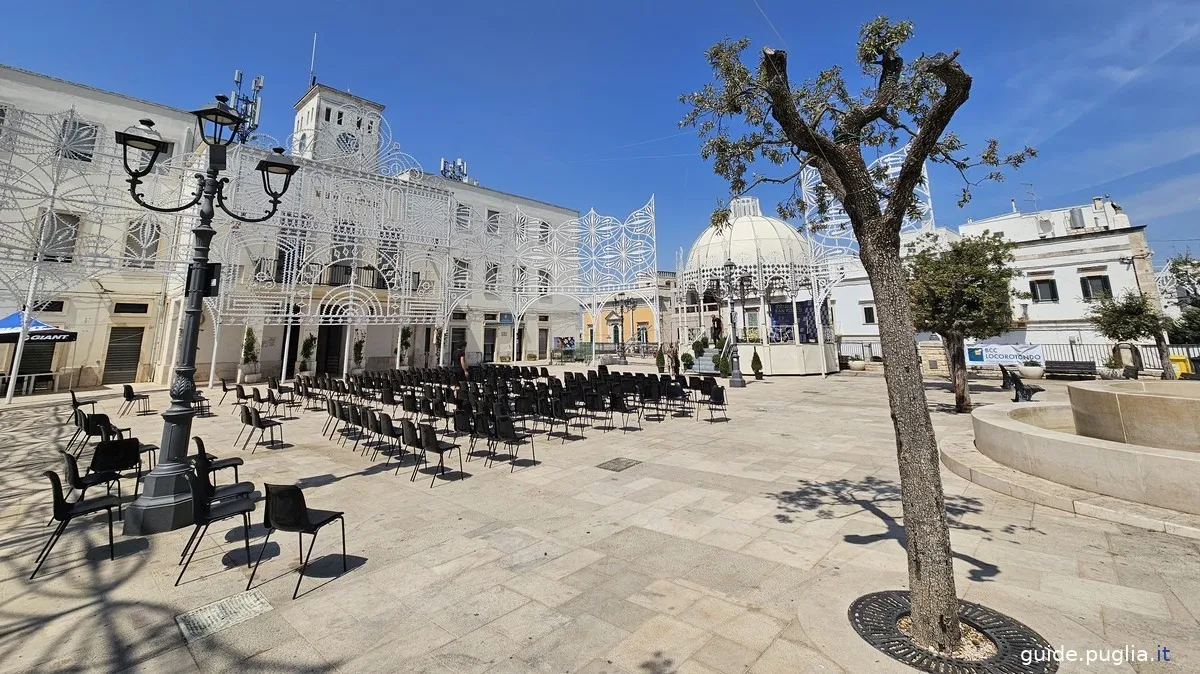
One of the most iconic places is the Chiesa Madre di San Giorgio, a jewel of Pugliese Baroque. Its imposing facade hides an interior rich in frescoes and stucco decorations, showcasing the mastery of local artists.
Just take a look from the panoramic terrace in the center of Locorotondo to let your gaze sweep over the entire Valle d'Itria, a mixture of scattered trulli and ancient masserie, nestled among cultivated fields, olive groves, and vineyards.
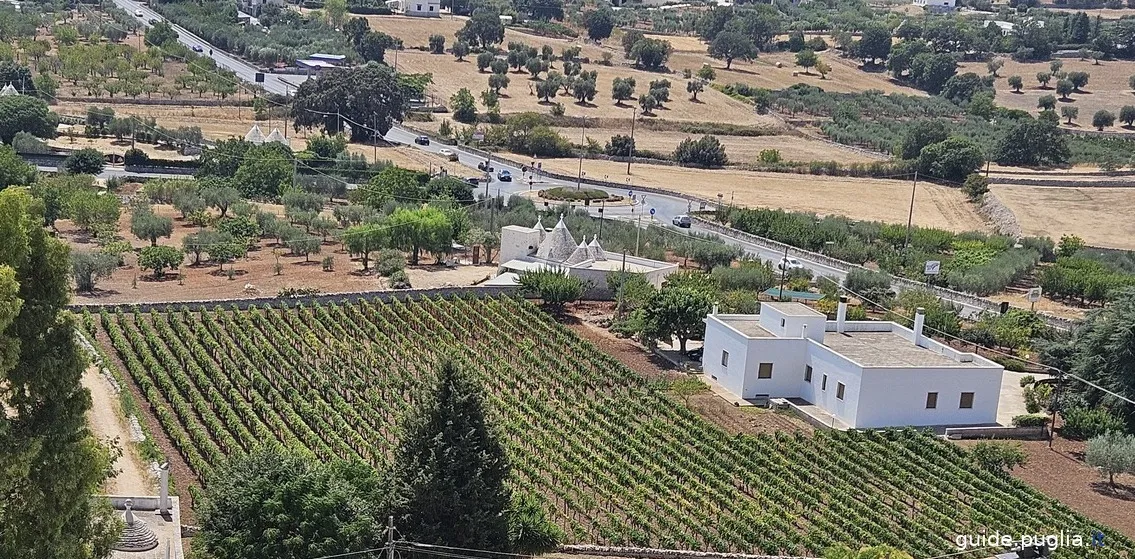
Not to be missed is also the Belvedere Santa Maria della Greca, right in the center of Locorotondo, on Via Nardelli. It is a panoramic terrace overlooking the Valle d'Itria and the surrounding trulli.
Here you can admire the surrounding landscape made up of small vineyards, patches of forest, and olive groves that stretch as far as the eye can see in the Valle d'Itria. You can enjoy one of the most beautiful views of Puglia and take unforgettable photos.
In the historic center, you can feel the community's care because everything is charming and intimate, conveying a sense of order, respect, and mature civilization.
The ancient heart is enclosed in its perfect circular stone shape, making it resemble a cake when viewed from the outside.
In Locorotondo, the white of the lime surrounds everything, providing a dazzling backdrop to the Baroque architecture in local stone and enhancing the flower-filled balconies in wrought iron.
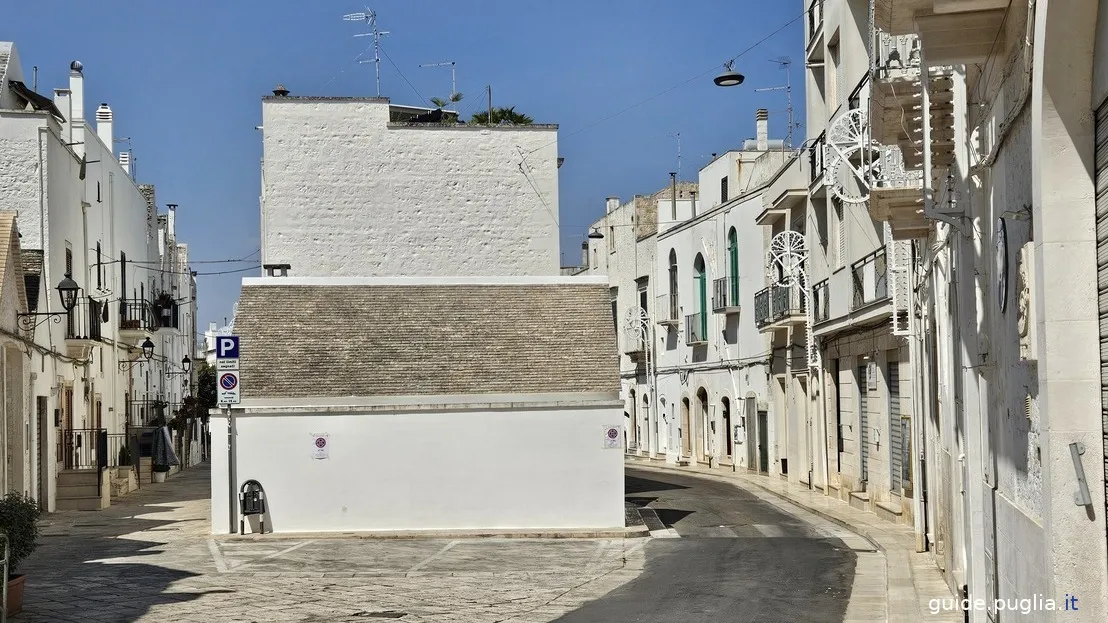
Walking through the narrow streets of the village of Locorotondo makes you feel like a true inhabitant of the village, where the sense of order and respect of the locals is palpable.
Finally, if you are passionate about history and culture, the Museum of the Territory "U. Granafei" is an experience not to be missed. The museum tells the story of the Valle d'Itria and its people through a vast collection of objects and testimonies, ranging from prehistory to the present day.
Locorotondo center historic houses, the Cummerse
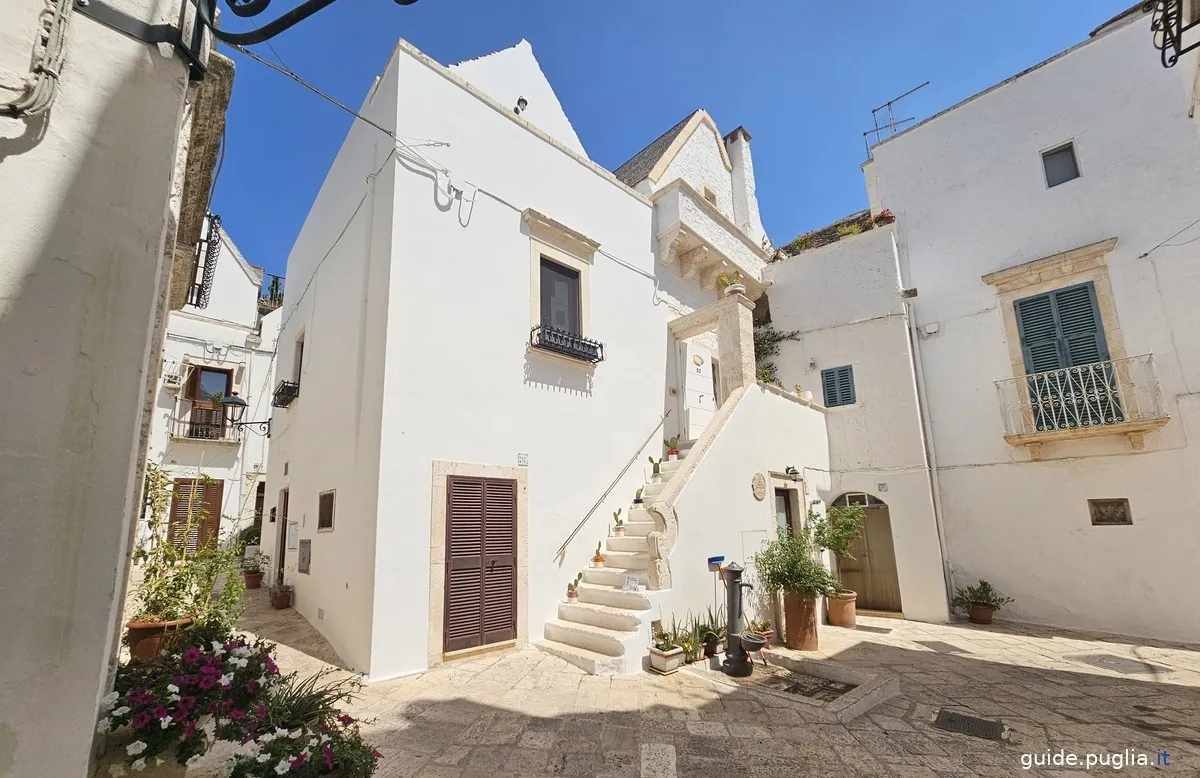
The peculiarity of the village of Locorotondo are the "Cummerse", small characteristic whitewashed houses with a sloping roof paved in black limestone, the chiancarelle, which, due to the extremely sloping shape of the roof, are reminiscent of the houses of northern Europe.
The Cummerse, together with the Trulli, are typical of the central town of Locorotondo and unique in the world of their kind.
Also thanks to this peculiarity, the ancient heart of Locorotondo is a unique place able to exert suggestions and charm out of the ordinary.
The historic center of Locorotondo is full of cobbled streets, elegant portals, flowered balconies between ancient stone houses with strange structures.
Local Handicrafts
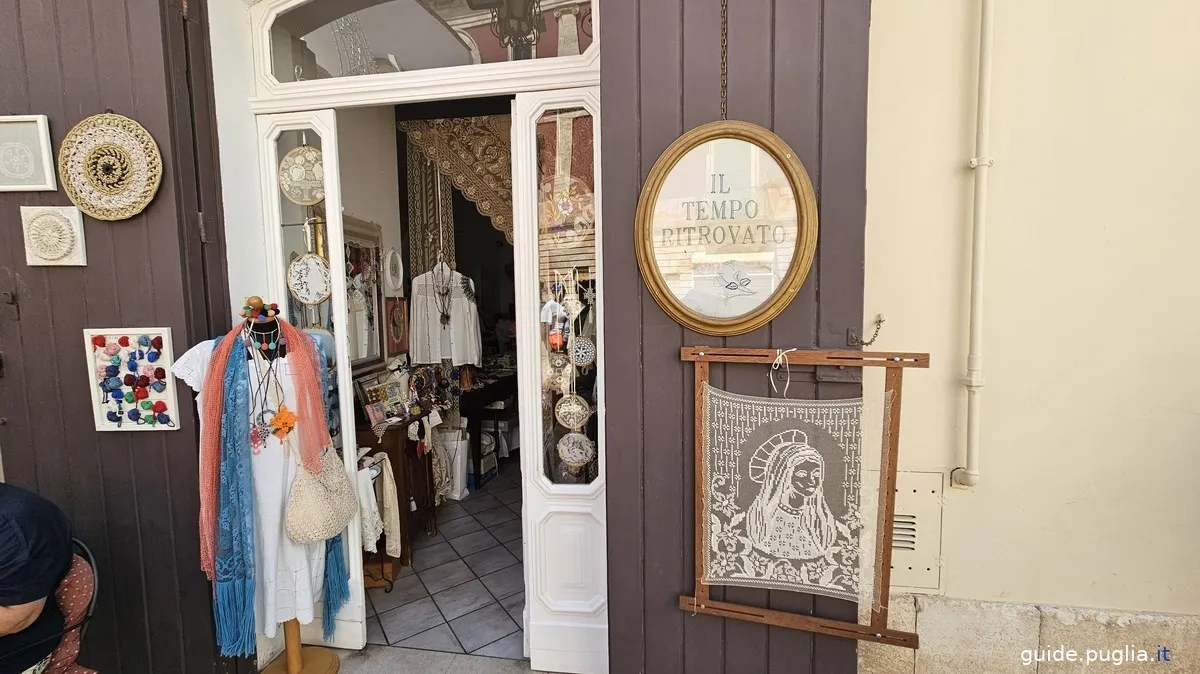
Locorotondo is a village that, in addition to its architectural and scenic charm, boasts a rich tradition of handicrafts. The local craft shops offer a wide range of unique, handmade products that reflect the culture and traditions of Puglia.
Here’s what you can expect to find in the local craft shops in Locorotondo:
Ceramics
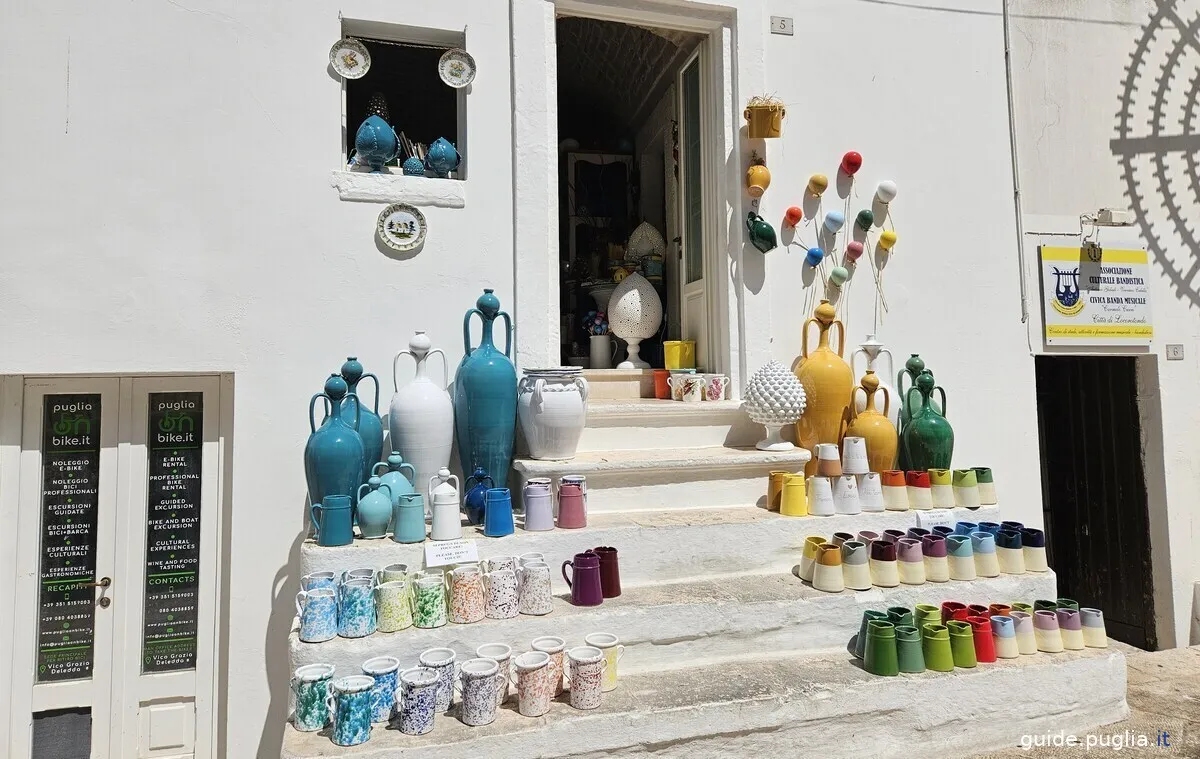
Pugliese ceramics are famous for their vibrant colors and traditional patterns. In Locorotondo, you can find a wide selection of handmade ceramics, from hand-painted plates and vases to small collectible items like pine cones and bells. These products are often decorated with typical regional symbols, such as flowers, olive leaves, and marine motifs.
Stone Products
The local stone, often used to build the trulli and other typical buildings, is also crafted into decorative items and utensils.
You can find small trulli miniatures, mortars and pestles, and other stone items that showcase the artisanal mastery of the region.
Textiles and Embroidery
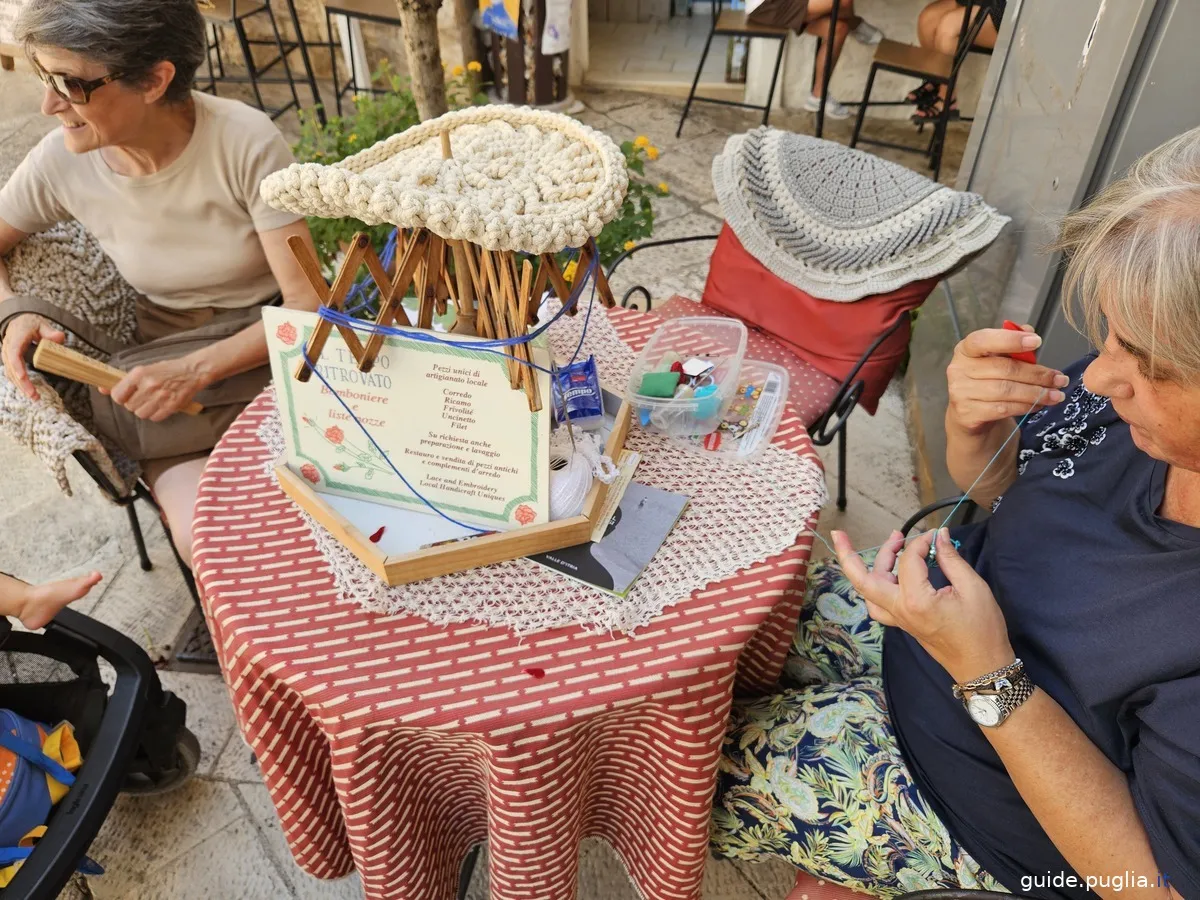
Textile craftsmanship is another distinctive element of Locorotondo. In local shops, you can purchase hand-embroidered tablecloths, towels, blankets, and other textiles, often featuring traditional Pugliese patterns.
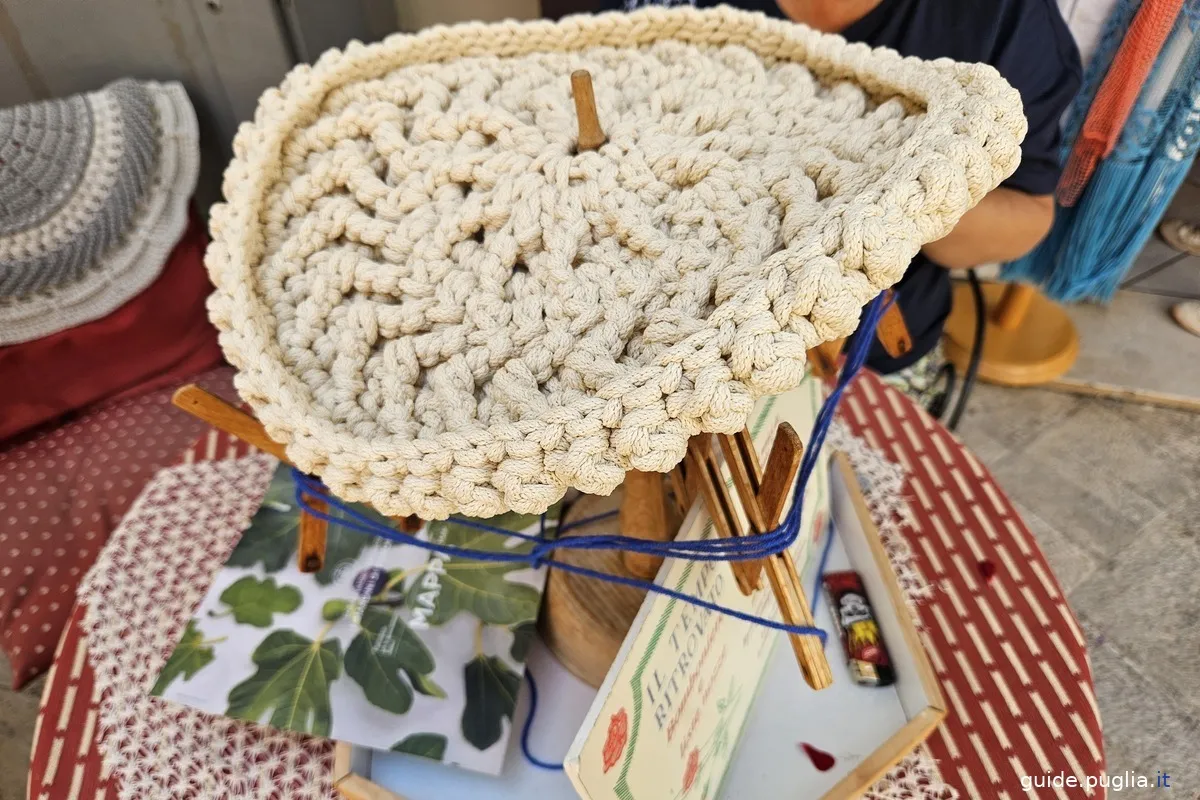
These items are perfect as souvenirs or gifts, as they combine functionality and beauty.
Wooden Items
Woodworking is another local tradition. You can find hand-carved items, such as kitchen utensils, decorative boxes, and statues. Local artisans often use fine woods like olive, which gives the products a unique character thanks to its distinctive grain.
Locorotondo what to do
Among the most beautiful things to do in Locorotondo are:
- enjoy the unique beauty of the village
- admire the area surrounding the village
- participate in traditional events in the village
- participate in events in the various districts
- see historic Trulli
- visit the churches
- enter the historic palaces
- visit Masserie and Agritourisms
- learn about the wine culture of the area
- live the olive oil traditions of the area
Locorotondo is one of the villages of the Itria Valley where you can enjoy the Mediterranean views and the surrounding landscape by walking quietly through the alleys of the historic center, jealously guarded by its inhabitants without any trace of neglect or decay.
The locations are so unique that they have hosted numerous film shoots of both Italian and international production.
You will be amazed by the beauty of the views and the serenity that naturalistic environments transmit.
Locorotondo is a destination for travelers and tourists throughout the year.
Locorotondo in Summer
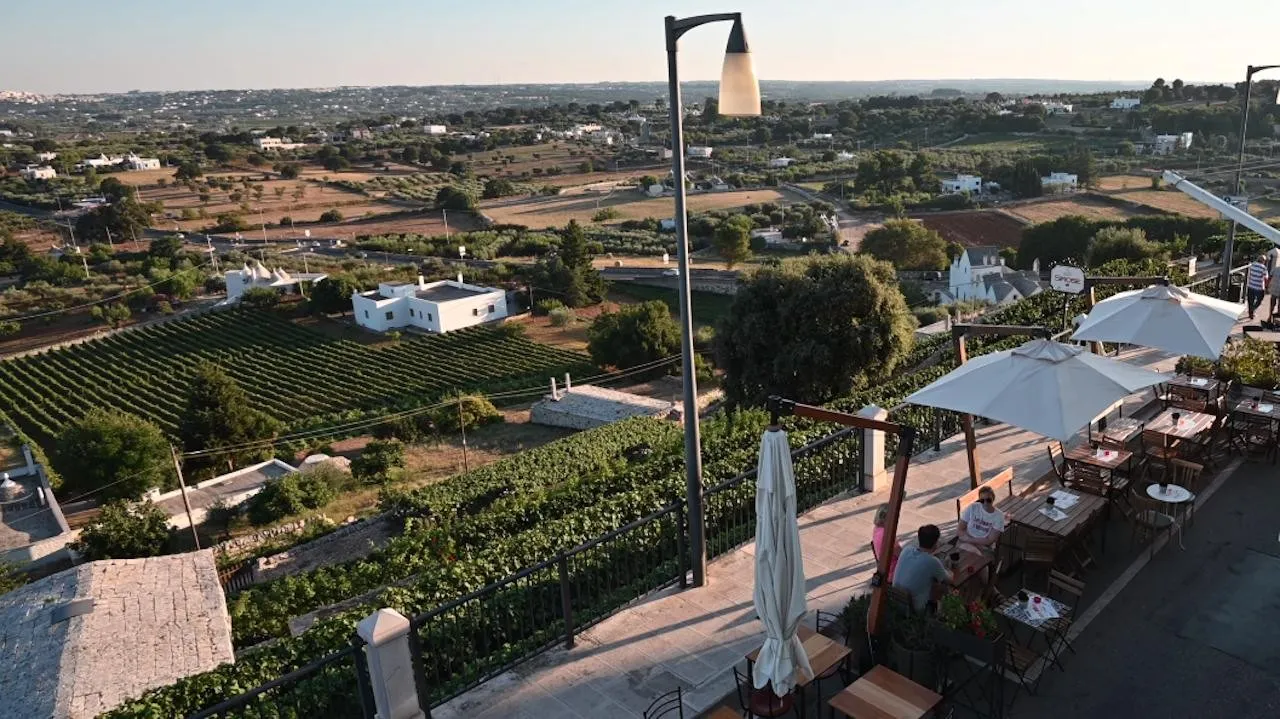
In summer the town of Locorotondo, together with the surrounding farms and trulli, becomes a refuge for tourists who want to experience a holiday away from the daily frenzy. Locorotondo becomes an idyllic place where you can relax and recharge, immersed in a timeless territory.
Staying in Locorotondo in the summer allows tourists to enjoy the fresh hilly air of the Itria Valley during the sultry summer days.
Going to the beach when you stay in Locorotondo is really easy and is a favorite activity during the hot summer days.
Spending the warm summer evenings on the hills of the Itria Valley, between the stone walls of the buildings, means a lot in terms of livability thanks to the hilly summer evening coolness.
Visit the Itria Valley
Valle d'Itria is one of the most beautiful places in Puglia for its luxuriant territory, rich in woods and game, for its wild landscapes and for the typical hilly Mediterranean nature.
Another unique feature of the Itria Valley in the world is how man has entered this territory, building wonderful villages with characteristic stone houses painted in white lime but above all for the massive presence, unique in the world, of ancient stone Trulli. and farms.
In the vicinity of Locorotondo, a few kilometers away, you will find Cisternino with its splendid countryside and Martina Franca with its marvelous baroque buildings and its summer music festival.
Sea near Locorotondo
The sea is just 15 km away and there are some of the most beautiful stretches of the Adriatic coast, with much of the coast under protection for decades.
The seaside place in front of Locorotondo is Torre Canne and a little further south is the wonderful Regional Natural Park of Dune Costiere, enclosed between Torre Canne and Torre San Leonardo.
If you want to spend a hot day at the beach then just travel 15 kilometers by car to find yourself on some of the most beautiful beaches and nature reserves on the Apulian Adriatic coast.
Locorotondo in Winter
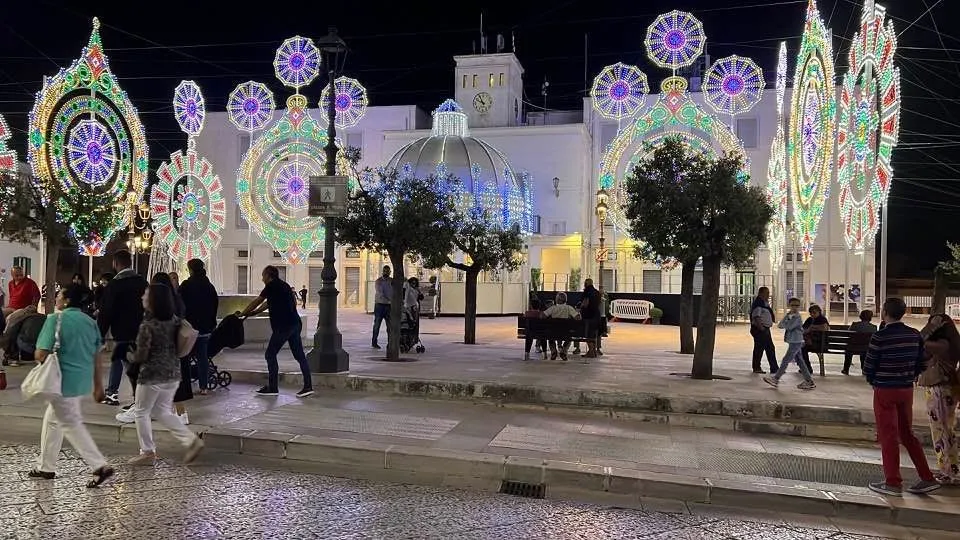
In winter the town of Locorotondo is covered with lights to shine during the Christmas period in the eyes of numerous visitors from all over the world.
The Christmas atmosphere in Locorotondo is really particular for the whiteness of its characteristic streets and for the unique traditional houses with sloping roofs, typical of the Nordic countries.
Events are organized annually that attract visitors for Christmas in Locorotondo to admire for example the Living Nativity, the Christmas Markets, the Festivals and other events that take place from the beginning of December until the day of the Befana which is January 6.
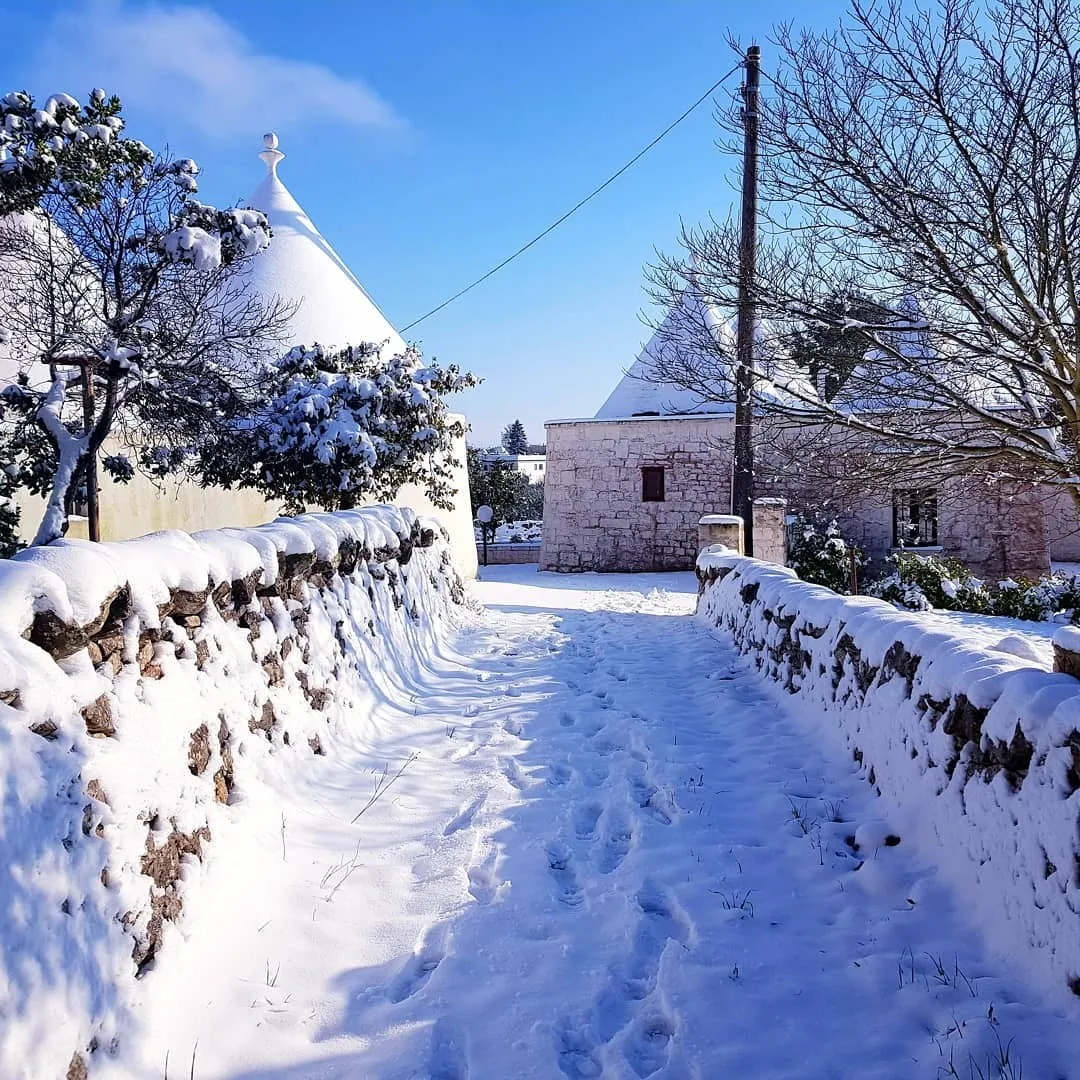
Staying in a Trullo or in a Masseria in Locorotondo when it is whitened by winter snow is for those who stay there a truly unique experience thanks to the fairytale atmosphere in which you are immersed, with ancient structures in stone and wood with a unique shape.
Being in Locorotondo when it is whitened by snow is an experience that many visitors do not fail to be present every year.
Reviews on Locorotondo: what to see and what to do
1 reviews
